Ludvig Sunström's Blog, page 10
December 2, 2014
Best Practices for Getting Ripped and Killing it (in the gym)
 I was talking to my friend Filip the other day (he’s the guy in the image).
I was talking to my friend Filip the other day (he’s the guy in the image).
We were discussing some of the mindsets and best practices behind getting ripped and having great gym workouts. Or as I call it — the philosophy of rippedness.
It was surprising, for us both, to notice how similar the core ideas of our gym-ideologies are.
In this article I’ve summarized some of our main ideas and practical tips.
Both Filip and I got ripped pretty fast after having set out to achieve that goal. He did it in just 1,5 years, while it took me roughly 2 years.
Actually, I think Filip had the fastest physical transformation I have ever seen. When we were 17-19, and still in high school (gymnasiet, as it’s called in Sweden) he went from looking like a little kid to looking like an Adonis.
The strangest part is that he didn’t even eat very healthy food. I thought it was unfair.
So I would tease him and say that he took steroids. This made him angry, as it discredited his hard work (I feel a little bad now). He worked out nearly every day at the time.
How his transformation happened so quickly, and how he grew so strong (he bench presses nearly 2x his bodyweight), was an enigma to me and many others at the time. We were extremely uninformed about fitness and nutrition.
We thought we couldn’t build muscle unless we ate lots of tiny meals all the time and, the idea of fasting would never have struck us as intelligent back in those days.
Anyway, despite my insinuations, Filip did not take steroids and never has. He’s just freakishly focused.
I’ve been to the gym with Filip a bunch of times and I’ve never seen anyone with more RAW intensity.
I’ve asked him lots of times what goes on in his head during workouts. He hasn’t been able to give me any detailed answer, as it seems like most of what he does, he does unconsciously — he just gets into this intense flow state.
So I asked him to think it over for a few days and pay extra attention what he does.
He did that — and these are the things he came up with. . .
Filip’s Advice for Killing it in the Gym
#1 Think of NOTHING when you do a set
Filip refers to this as mindfulness:
When I do a set I let go of all my thoughts and focus completely on the muscle I am working. To really feel your muscles and to be able to contract them as tightly as you possibly can when you lift is the most important thing in the gym, in my opinion. It can be hard to focus on just ONE muscle, and letting go of everything else, but I think mindfulness (in general) is a good way to practice what I call “entering a specific muscle”.
I think it takes a while for a “newbie” to learn how to really consciously FEEL his or her muscles.
I strongly concur with this. Most people I see in the gym are mindlessly going through the motions — there’s no intent in what they’re doing. No force of will behind the movements. They don’t want to face the pain.
#2 Always do drop sets .
For example, say I’m doing shoulder press with 30 kg dumbbells, I’ll drop down to 17,5 kg dumbbells after I’m too tired to do another set on the 30 kg ones. That way I am able to push out more reps than I would have otherwise.
A drop set is when you start with a heavy weight and do as many repetitions as you can with it until you reach failure. After reaching failure you immediately use a less heavy weight (I like to drop down to 50 % of the heavy weight) and lift until failure again.
#3 Failure trumps form
When you get tired — and reach failure — it’s more important that you try for another rep, even if it’s shitty form, than it is that you give up.
Try not to use a spotter (unless you’re lifting really heavy), because if you do that then you’ll KNOW that you can lift that weight, and that’s not mentally challenging or risky enough for you. You want to put yourself in a position where it’s EAT OR BE EATEN, where the reptile part of your brain takes over and you’re forced to lift that weight. As opposed to half-heartedly lifting the weight with assistance from a spotter.
Obviously, this is for big boys only.
#4 Flex after workouts
I think it’s a very good idea to flex your body as hard as you can after a workout to see the results; try to see different parts of your body that can be improved, and think about how this might be done best.
I also like to think about — and visualize myself — working out as I go about my day.
#5 Some muscles you have to SLAUGHTER . . .
. . . Such as calves.
For those muscles you have to go over a certain threshold to reach great results. I’m not sure where this threshold is, but I can feel that when I pass that threshold, the muscle feels very different, it’s as if you have to put it through a serious beating before it understands that it’s supposed to grow!
Interpretation: What he means by that is that you need to do a lot more sets than you are initially comfortable with.
In my opinion these are the muscles that must be “slaughtered”:
Calves
Wrists
Triceps
Stomach (if you’re doing it, which shouldn’t really be necessary if you are doing heavy compound lifts)
Thanks for the tips, Filip!
I realize some these tips may seem like total bro-science. Nonetheless I stand by their value. These things work great for me and Filip — and, hopefully they will work well for you too.
Also, so-called science related to working out or bodybuilding is usually not the most trustworthy sort of science. Self-experimentation is much most important, as people have different bodies.
Now, let’s get into my advice.
Ludvig’s Mental Principles for Killing it in the Gym
#1 Create a powerful pre-workout ritual
I’ve thoroughly explained my strategy for becoming addicted to working out.
But here’s a recap:
Create positive associations with working out
Use operant conditioning by tying a reward to working out
Listen to good music and do other things that put you in an upbeat mood
When done together you’ll create an addictive (positive) feedback loop which should effortlessly put you into flow.
#2 Use contrast bias to lift more/heavier weights (than you would otherwise be able to)

Contrast bias displayed visually.
Contrast bias is the reason your brain does not evaluate things objectively, but always in relation to something else. A good example being how contrasting colors stand out.
You’re using contrast bias to your advantage in the gym when you:
Do lighter drop-sets after your original set (Example: original set = 30 kg dumbbells | drop-set = 20 kg)
Do pyramid sets (Example: 50 kg, 75 kg, 100 kg, 75 kg, 50 kg)
Contrast bias is the reason why doing a drop-set of several lighter repetitions is easier than doing one more repetition with the heavy weight. Physically speaking, this may be just as hard, but mentally it is perceived as easier by your brain.
I say it all the time, but it bears repeating: The mental aspect of gym-going is probably more important than the physical aspect. Mind over matter.
#3 Belief is important — always stretch it
Henry Ford said that “Whether you think you can or whether you think you can’t, you’re right,” and when it comes to working out or lifting weights in the gym, I find this to be the case most of the time.
It is rare that I can lift more (repetitions) or heavier (weight) than I believe I can. I think Filip’s idea of not using a spotter — “eat or be eaten” — so that you feel less secure, works by the same logic.
So what I do every workout is that I try to do a little more than I believe I can do, whether that means doing a few more reps or setting a new 1 rep maximum record. I always try to break records and usually I succeed.
If I’m out running and I’m almost home and I feel like I can barely make it, I’ll force myself to go around the block one more time before coming home.
Real-life example of #2 and #3:
Some time ago I broke my record in deadlift. I tried to do one rep on 200 kg and failed twice. On my third try I succeeded. My next set I did 3 repetitions on 190 kg, with a short rest in between each lift.
Question: Why was it harder for me deadlift 200 kg once than it was for me to do 3 reps on 190 kg?
1) Because of contrast bias:
Had I started with 210 kg (and failed) I would perhaps have made the 200 kg lift on my first try instead. Dropping down from 200 kg to 190 kg creates a mental contrast which makes the brain perceive it as easier.
2) Because of belief:
I have done 190 kg deadlifts many times. I know in my mind that I can do it because I’ve easily done it before.
I had never successfully done a 200 kg deadlift before — so, of course I did not feel confident I could do it. There was a mental barrier to overcome.
#4 Use incremental change to break records and increase motivation
It is easier and often better to change things a little bit at a time — incrementally — than it is to make big sudden changes. There are many reasons for this. . .
. . .Where a major reason is motivation.
When you break a record or outdo yourself you get lightning-fast positive feedback that motivates you. Motivation in turn is incredibly important and you should consider it a scarce resource (like time and energy).
By stepping up your workouts incrementally you’ll receive more total motivation than you will compared to if you made just one big sudden step.
A person who is new to the gym and has a maximum potential of 100 kg in bench press (that he does not know of) is better off increasing his record many times over by 2,5-5 kg at a time, compared to if he were to do it once at 70 kg and then one more time at 100 kg. Make sense?
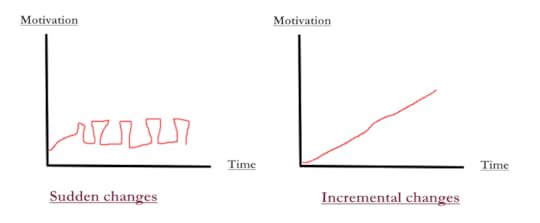
Real-life example of #3 (belief) and #4 (incremental change):
I try to stretch my belief so that it becomes “logical” for me to be able to do something. For example, recently I did 4 slow repetitions of dumbbell bench press with 47,5 kg. But at the same time I had never done a single repetition of 100 kg normal bench press. This angered me.
So I told myself I should easily be able to do one repetition of 110 kg bench press. . .
. . .But not immediately.
Instead, I got there incrementally — by breaking my record a little at a time over 2 weeks. 100 kg one workout. 102,5 kg the next time, followed by 105 kg, followed by 107.5 kg, and finally 110 kg the last one. This does two positive things for me:
Makes me happier (more motivated)
Gives me a stronger belief (because it is based in more repetitions)
#6 Speed up your recovery time and stay focused
Warren Buffett says that even if you have really high IQ, without being rational you won’t be able reach your intellectual potential.
The same principle holds true when you’re lifting.
You may have the physical potential to do a 200 kg deadlift, but if your mental focus is off you probably won’t be able to lift more than 170 kg that day. And to stay mentally focused you need to relax.
Here’s how I do that:
I make sure I am breathing properly — into my stomach, not my chest
Before doing a heavy lift I shake my body to loosen up, exhale and relax my muscles (this looks weird, but it works)
I check my pulse by holding my hand over my stomach.
Checking my pulse also acts as a way to gauge my awareness level and it calms me down, because my mind has learned to associate it with relaxing.
#7 Using “power moves” to boost your state
This one is a little bit wacky, but it also works.
(Warning: People may think you’re a retard.)
“Power moves” are physical movements that boost your motivation and, with practice, can put you in flow state. They work by two principles:
Association and repetition
By affecting your physiology (this is why power posing works)
I like to use certain power moves in combination with my pre-workout ritual. They help me go from being rational and logic to putting me in a meditative state where I’m focusing on my body and not thinking so much. The more you practice, through repetition, the better it gets. I like to:
Use power posing and put my hands above my head (I do this while running as well when I’m really tired and feel like quitting)
Rhythmic movement to whatever music I am listening to
Flexing my body as hard as I can (ABF — always be flexing!)
#8 Create and use a “lock-in” move
A lock-in move is like an upgrade to power moves. I like to do it right before challenging lifts or after breaking a record.
There are two reasons why you want to do them:
Get extra motivation
Lock-in this moment in your memory
I know what you’re thinking: What does memory have to do with working out or lifting weights in the gym?
A lot actually — because it builds your belief.
The more emotional intensity and detail you can add to a memory, the better you will remember it. The better you remember something the more you believe it and the more confident you get.
So — each time you do something you’re proud about in the gym you want to “lock-in” that moment.
I do this by making a clap, that’s my lock-in move.
Again, this is for big boys only. Most people don’t dare to do this, and risk looking weird.
Maybe you don’t like clapping your hands as much as I do. But the trick here is not in the specific movement, it’s about how it makes you feel.
Try out different movements and see which ones make you feel the most powerful.
If you’re clueless about what power moves you can use. . .
. . .Here’s some inspiration:
Or check this video after 4 min 22 sec.
Do you have any best practices or mental tips related to working out?
Photo credit: Wikipedia
The post Best Practices for Getting Ripped and Killing it (in the gym) appeared first on Startgainingmomentum.
November 24, 2014
How to Have Awesome Workouts [Warning: you may become addicted]

It’s 4 PM.
That means it’s time to hit the gym. I’ve been looking forward to this all day long.
I don’t need to get ready. I got ready an hour ago.
I am already wearing my gym clothes. I am prepared physically and mentally.
When I have these clothes on me, I feel like lifting heavy weights.
When I put on my workout clothes I start my pre-workout routine by activating familiar positive mental associations. This makes me feel good.
I’ve drilled this process over and over for the past 3 years.
Before I walk out the door I do a power pose, I stand with my hands above my head and keep my back straight. Then I move around a bit to the rhythm of the music I am listening to — to enter flow state.
I start focusing on my breathing and shift my focus from random thoughts into the core of my body.
I start walking towards the gym.
I feel inclined to walk my usual–(habitual)–route towards the gym. Doing that requires less mental energy. Fortunately, my metacognition expertly alerts me of this. . .
. . . So I force myself to walk another route to the gym. A new route. I can feel a new mental pattern emerge, as a result of deliberately inducing novelty and variation into my life. It’s a small decision, but it is necessary for breaking out of homeostasis.
I look dead ahead.
My gaze is calm, focused and steady. I walk upright. I have an excellent posture.
I feel good.
I feel strong. . .
I feel like I want to explode.
But I don’t.
I hold it in. I’ll save that energy so that it reaches a crescendo for when I intend to break a record 15 minutes from now.
I enter the gym.
I take off my shoes and go down to the dressing room. I put my gym bag in a new locker every time to avoid routine behavior.
Then I do a warm-up set of some compound exercise (only 10-14 more sets to go now).
The Mental Aspect of Your Workouts. . .
. . . Is just as important as the physical aspect.
Probably even more important.
Arnold Schwarzenegger said that one set executed with strong mental focus was better than several sets done mindlessly.
This makes perfect sense to me.
Working out = meditation
There have been studies of people imagining themselves lifting weights — and those people were able to slightly increase their physical strength and muscle mass by doing so.
My experience is that the best-looking, strongest and healthiest people are those who consciously and consistently:
Summon strong emotions during the workout (leave it all in the gym)
Feel their body during the workout (no thinking, just feeling)
Infuse as much intent as possible into each workout (“one more rep!”)
. . . And I think these things are heavily overlooked by most people.
I constantly see people in the gym who are messing with their cell phones, gossiping with their friends or fidgeting about excessively.
All of those things distract them from building up their focus to enter a meditative state (flow) of deep concentration. This leads to a negative downward spiral:
Because of their poor mental focus they fail to generate positive emotions as they are lifting.
As a result of this they associate lifting with pain, instead of pleasure.
Since they associate the gym with pain they make slow progress. . .
. . . And they end up with average physiques!
This is logical, because they’re putting in a minimum of effort; trying to avoid pain rather than finding some way of making their workouts pleasurable.
They’re not at the gym because they enjoy it.
They’re just there because someone told them it was good for them.
Let’s look at how to make your workouts great and enjoyable, starting with. . .
Getting Addicted to Working Out

Here’s how the guy looked 3 years ago.
Let me tell you a story.
There once was a guy with an average physique who could see the benefits to working out, as lots of people had told him it was a good thing to do. But he was struggling with consistency in the beginning, because he was unconsciously trying to avoid pain during his workouts.
Fortunately, he was smart enough to understand that if he wanted to become consistent at working out, he would need to get himself addicted to lifting and start enjoying the long-term process.
So he ordered himself some unhealthy–but powerful–pre-workout stimulant and started consuming it right before each workout he did. That instantly boosted motivation.
Next he created a pre-workout routine to mentally separate working out from the rest of the day, so as to clearly show his brain that this activity was exceptionally important. He did this by setting aside 15 minutes before each workout, where he would sip his pre-workout stimulant, distance himself from computer screens and people to meditate briefly — to stop thinking and start feeling.
The result of this was that the stimulant gave him a lot of energy and the meditation gave him intense mental focus.
This made him feel really good.
After about a month of doing this several times per week it became the highlight of his day.
Once that had happened he replaced his addictive pre-workout stimulant powder with eating 2-3 teaspoons of raw cocoa, which is a natural stimulant that is much healthier (and doesn’t contain strange chemicals).
In addition to these things he also made sure that he listened to motivating music during workouts. To avoid exhausting the motivational value of these songs he listened to them exclusively during workouts, never otherwise. As soon as one of his songs no longer gave him a motivational boost he ruthlessly replaced it with a new one that did. He updated his song list religiously to only have potent workout songs.
Fast-forward three years and he looked like this. . .

Oh yeah and, by the way, the guy in the story is me.
And I’ve never skipped a workout since I began this routine.
Not because I have supreme willpower or anything, actually, you don’t even need willpower when you are. . . ADDICTED.
Now then, let me tell you. . .
Why This Works (and how it gets you get addicted)
This process (as described above) produces a number of psychological effects:
First, the pre-workout ritual contains a number of cues (putting on my workout clothes, eating cocoa, etc.,) which trigger specific habitual behavior I’ve trained myself for, namely, to get myself pumped up.
Second, it works by classical conditioning (Pavlovian association) which induces stimuli associated with positive emotions (lifting is associated with flow state).
Thirdly, it works by operant conditioning (positive reinforcement) which rewards my behavior with the good emotions (endorphin high after pushing through pain).
When I put it like this it seems like these effects are separate but, they are not. They all work together.
In combination they trigger the brain’s spreading activation which starts to trigger thoughts, emotions and memories that are closely associated to my “gym-state”.
And it becomes a powerful, and very addictive, feedback loop:
When you get inside this feedback loop you’ll quickly see positive results in terms of building muscle, strength or losing weight.
And when you start seeing gains, you’re breaking records and getting other positive feedback, your motivation goes up.
This in turn boosts your testosterone and dopamine, which may propel you into a winner effect
Need I say more?
In fact, I find this process so heavily addictive that my situation is the exact reverse of most people; most people have to force themselves to workout. I have to force myself to not workout.
Now let’s do quick recap. . .
Summary
Try to combine all three of these feedback loops for maximum impact.
Positive feedback loop #1
Create a pre-workout ritual = buy yourself some addictive stimulant and take it at a certain time each day before working out. Get away from the computer and sit down for a 10-15 min meditation to shift your focus from your head to your body. Do a power pose and move around a little.
Positive feedback loop #2
If you did your pre-workout ritual well you should be energized and focused:
Better focus = More fun
More Fun = Positive mental associations
Positive Associations = You will naturally want to go to the gym
Do this consistently and you’ll soon be like Pavlov’s salivating dogs when he rang his bell– only you’ll be aching to lift weights or go for a run.
Positive feedback loop #3
Operant conditioning = Push yourself hard enough in the gym to trigger an endorphin rush
Keep excellent music for workouts = Ruthlessly remove a song when it no longer motivates you and, don’t listen to these songs except when you’re working out. Songs are like drugs, the more you do them, the less efficient they are.
Get “fast” mental feedback = By flexing in the mirror (to see how chiseled you are) and so forth.
That in turn may put you in yet ANOTHER feedback loop — the winner effect — where you want to put in more time and want to outdo yourself, break new records and get better.
And it’s powerful stuff.
However, if you’re in a position where you’re mentally struggling for each workout. . .
. . .Remember, it takes a while to reverse:
You can’t get stronger physically and mentally unless you’re having pain, because you’re stretching yourself, you’re going into a new level. So pain is good if you’re exercising, right?
Go exercise at the gym. It starts off painful, but as you start to get going with it, and you start to see the benefits of it, and you start to actually change your brain physiology in terms of what determines whether it’s painful or not, it becomes pleasurable. Behavioral modification usually takes place over about 18 months of doing something. So you start to get into an environment where it’s pleasurable.
–Ray Dalio, CEO of Bridgewater
Most people fear the pain of doing that extra repetition.
If you do these things, you’ll start looking forward to the pleasure of doing that extra repetition.
The post How to Have Awesome Workouts [Warning: you may become addicted] appeared first on Startgainingmomentum.
November 8, 2014
Another 23 Excellent Books You Should Read
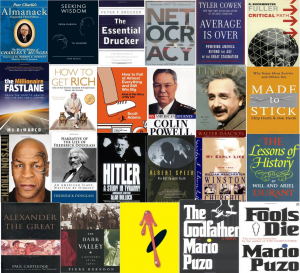
One of the questions I get asked most via email is if I have any good book recommendations.
I do indeed.
23 of them actually.
Most (modern) books contain only 1-3 big ideas. These 23 excellent books contain more than that.
Let’s start with. . .
Business & Success Philosophy
Why should you read these type of books?
For the obvious reason: To get ahead in life.
Poor Charlie's Almanack: The Wit and Wisdom of Charles T. Munger, Expanded Third Edition
 Poor Charlie’s Almanack: The Wit and Wisdom of Charles T. Munger
Poor Charlie’s Almanack: The Wit and Wisdom of Charles T. Munger
Poor Charlie's Almanack: The Wit and Wisdom of Charles T. Munger, Expanded Third Edition
 This is the best book I’ve read in 2014.
This is the best book I’ve read in 2014.
It contains the most important thoughts, mental models, scientific theories and business strategies of one of the smartest men alive: Charlie Munger.
Munger is the business partner of Warren Buffet. And, just like Buffet, Munger is a self-made billionaire. I will re-read this book many times over my life (there’s simply too much wisdom in it to take in at once).
If you’re into behavioral economics, it should interest you to know that Charlie basically came up with it, and has the smartest system I have seen for applying that knowledge to different fields of life. Business in particular.
The book’s name — Poor Charlie’s Almanack – was chosen to honor Charlie’s role model, Benjamin Franklin, who wrote a book called Poor Richard’s Almanack.
[Note: Reading this book will give you another 20 excellent book recommendations.]
Seeking Wisdom: From Darwin to Munger, 3rd Edition
 Seeking Wisdom: From Darwin to MungerSeeking Wisdom: From Darwin to Munger, 3rd Edition
Seeking Wisdom: From Darwin to MungerSeeking Wisdom: From Darwin to Munger, 3rd Edition

This is the second best book I’ve read in 2014.
Some of its content or main ideas are the same as in Poor Charlie’s Almanack. But much of it is different or explained with new examples.
I suggest you read this book after PCA as it’s a bit tougher to read. This book has zero fluff in it. It is packed with useful information from start to finish. It contains a lot of thought-provoking thoughts and questions. I had to stop and take a break to digest what I had read many times.
[Note: As I said, these two books are the best I've read in 2014. Hence I spent a proportionate amount of time studying them. These two books took me over a month (combined) to read, because I transcribed very large portions of them into my commonplace
and my book summary book.]
How to Fail at Almost Everything and Still Win Big: Kind of the Story of My Life
 How to Fail at Almost Everything And Still Win Big
How to Fail at Almost Everything And Still Win Big
How to Fail at Almost Everything and Still Win Big: Kind of the Story of My Life
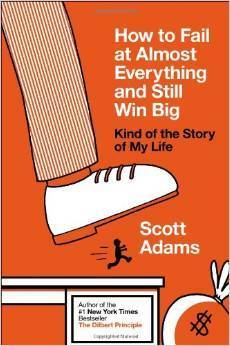 Scott Adams is the creator of the popular comic strip Dilbert. He is also a serial entrepreneur who has tried and failed a lot of things — and led and interesting an inspiring life.
Scott Adams is the creator of the popular comic strip Dilbert. He is also a serial entrepreneur who has tried and failed a lot of things — and led and interesting an inspiring life.
There is a lot of wisdom and life experience condensed in this short book. It’s an easy and fun read. Even a kid could learn from it.
If you’re young I would recommend you read this book before PCA and Seeking Wisdom. Those books are incredibly good, but they assume that you have a certain knowledge-base. This book will give you much of it.
Adams recommends you to learn how cognitive biases work so that you can remain rational and use your brain to its full potential.
The Essential Drucker
 Peter Drucker was a business philosopher and “management guru” (he basically invented the term “management”). He wrote 30-something books over his 95-year old life. The Essential Drucker contains most of his big ideas. Everyone should read it.
Peter Drucker was a business philosopher and “management guru” (he basically invented the term “management”). He wrote 30-something books over his 95-year old life. The Essential Drucker contains most of his big ideas. Everyone should read it.
How has the profitability of the main industries during 1960-2000 gone?
Manufactured goods: -60 %
Farm and food products: -70 %
Information products (including education and healthcare): 300 %
Did you know that?
Towards the end of his life Drucker was interested in the advent of information society. He believed we would soon stop living in cities and work from home – anywhere — via computers.
This brings us to the two next books. . .
NETOCRACY: the new power elite and life after capitalism
 Netocracy
NetocracyNETOCRACY: the new power elite and life after capitalism
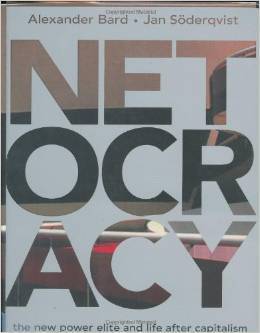 It’s actually called The Netocrats. When I talked to its author, Alexander Bard, before writing The Bard Notes, he informed me of this.
It’s actually called The Netocrats. When I talked to its author, Alexander Bard, before writing The Bard Notes, he informed me of this.
The real value of this book is that it puts the paradigm shift of information society in a philosophical and historical context. It also contains a ton of useful and interesting trivia.
Check out The Bard Notes for a better summary.
Average is Over
 Like The Netocrats, Average is Over is also a book about the future. But it is more practical and focuses on the future of the job market of the US, based on statistics and research.
Like The Netocrats, Average is Over is also a book about the future. But it is more practical and focuses on the future of the job market of the US, based on statistics and research.
One noteworthy example is that the wages for nearly ALL jobs have decreased by at least 5-10 % over the last 50 years, with the exception of highly educated people and entrepreneurs. This trend is likely to get continue.
Key points:
There are three things that are scarce in today’s economy:
1) Quality land and natural resources.
2) Intellectual property or good ideas about what should be produced
3) Quality labor with unique skills.
Unique skills, as in: Cannot be replaced by a machine.
If you and your skills are a complement to the computer, your wage and labor market prospects are likely to be cheery.
You should read this book if you’re into futuristic philosophy and marketing.
The Millionaire Fastlane: Crack the Code to Wealth and Live Rich for a Lifetime.
 The Millionaire The Millionaire Fastlane: Crack the Code to Wealth and Live Rich for a Lifetime.
The Millionaire The Millionaire Fastlane: Crack the Code to Wealth and Live Rich for a Lifetime. Fastlane
Fastlane The Millionaire Fastlane: Crack the Code to Wealth and Live Rich for a Lifetime.
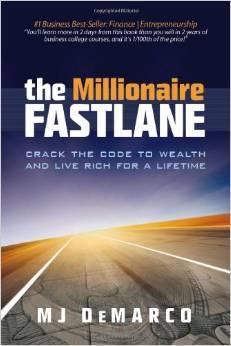 This is a great business book in terms of entrepreneurial mindset and practical tips. MJ DeMarco makes a distinction between two kinds of people in the world of success: Fastlaners and slowlaners.
This is a great business book in terms of entrepreneurial mindset and practical tips. MJ DeMarco makes a distinction between two kinds of people in the world of success: Fastlaners and slowlaners.
Fastlaners are entrepreneurs who take intelligent risks and operate by the wealth formula of leverage multiplied by impact. Slowlaners are (most) people who (falsely) believe they can get really RICH by improving their intrinsic value through formal education and selling their time for money. DeMarco spends much of the book convincing you why the slowlane-strategy won’t make you rich.
Key points:
Don’t be concerned with cutting miniature expenses. Create a great product or service instead.
Make your decisions with time as the #1 factor (instead of money, like most people do).
Maximize time. Time buys money — not the other way around. Money can be made. Time is non-refundable.
And one of the best quotes from the book:
Your choices have significant trajectory into the future, and the younger you are, the more horsepower they exude. Unfortunately, horsepower fades with age. When you are under 25 you have maximum horsepower and your choices discharge an incredible amount of firepower.
DeMarco likes to use car analogies and uses them extensively throughout the book.
How to Get Rich: One of the World's Greatest Entrepreneurs Shares His Secrets
 How to Get Rich
How to Get RichHow to Get Rich: One of the World's Greatest Entrepreneurs Shares His Secrets
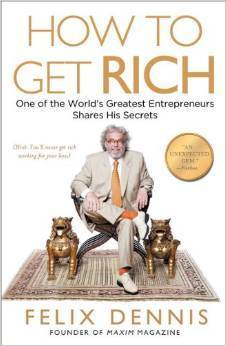 Written by Felix Dennis, the publishing empire billionaire, who owned Maxim Magazine among other enterprises. The book is autobiographical and chronicles Felix rags-to-riches story, while giving some good business advice along the way. The core advice can be summed up in two parts.
Written by Felix Dennis, the publishing empire billionaire, who owned Maxim Magazine among other enterprises. The book is autobiographical and chronicles Felix rags-to-riches story, while giving some good business advice along the way. The core advice can be summed up in two parts.
Mindset:
Never talk negatively about yourself.
You will never get rich if you care what anyone thinks of you. You need killer instinct. You have to get over fear of failure.
You will never get rich as an employee. Not even as a manager
If you want to be rich, you are not looking for a “career,” except as a launch pad or as a chance to infiltrate and understand a particular industry. A job for the rich-in-training is merely something to keep you ticking over, to put food on your plate and wine in your glass.
Business:
Ownership is power — hold on to stock
Diversify your risk. Create new baskets of wealth (like Richard Branson)
Sell early. Get out while the going is good (this was Felix’s biggest personal challenge)
Biographies
Why I read biographies:
To study the lives of the greats, learn vicariously from their successes as well as their mistakes and to implant them into my Dunbar’s number
For the motivation and inspiration they provide
Because they often contain useful historical trivia
Colin Powell: My American Journey
 Colin Powell is the posterboy for self-development.
Colin Powell is the posterboy for self-development.
He grew up in Harlem, the son of two Jamaican immigrants, and made it to Secretary of State and army general. His journey is inspiring and oozes of hard work, discipline and intelligence. Powell has a number of life principles that he abides by. He tells stories for how he picked up each of these principles. The most important principle, in my opinion, is to always “check small things” to avoid unnecessary mistakes.
Growing up Powell was average at just about everything. Until he joined the military reserve as a college student and realized he was a natural leader:
It was only once I was in college, about six months into college when I found something that I liked, and that was ROTC, Reserve Officer Training Corps in the military. And I not only liked it, but I was pretty good at it. That’s what you really have to look for in life, something that you like, and something that you think you’re pretty good at. And if you can put those two things together, then you’re on the right track, and just drive on.
You’ll also learn many interesting trivia about the military and how things work in politics.
Einstein: His Life and Universe
 Einstein: His Life and UniverseEinstein: His Life and Universe
Einstein: His Life and UniverseEinstein: His Life and Universe

This book is not an easy read — compared to the Steve Jobs book, also written by Walter Isaacson — but it is an educating read. About half the book is devoted to understanding Einstein while the other half — which is hard unless you know some science — is spent explaining:
The history of physics and the context in which it has evolved
How various theories in physics work
Einstein was a freakishly hard-working man. You have surely heard the story of how he took the job at the patent office in Bern so that he would have time to work on his theory of relativity (he did his patent work in just a 2-3 hours, kept a bunch of papers on his desk to appear busy, and spent the remaining hours working on physics).
What you may not have heard is that to further maximize time spent working he wrote a contract to his wife Mileva Maric stating:
You will make sure:
– that my clothes and laundry are kept in good order;
– that I will receive my three meals regularly in my room;
– that my bedroom and study are kept neat, and especially that my desk is left for my use only.
You will renounce all personal relations with me insofar as they are not completely necessary for social reasons. Specifically, You will forego:
– my sitting at home with you;
– my going out or travelling with you.
You will obey the following points in your relations with me:
– you will not expect any intimacy from me, nor will you reproach me in any way;
- you will stop talking to me if I request it;
- you will leave my bedroom or study immediately without protest if I request it.
You will undertake not to belittle me in front of our children, either through words or behaviour.
Undisputed Truth
 Mike Tyson: Undisputed Truth
Mike Tyson: Undisputed Truth
Undisputed Truth
 This is probably the best written biography I have read (most entertaining).
This is probably the best written biography I have read (most entertaining).
The first half (ca 300 pages) is amazing. You learn about Mike’s brutally traumatic upbringing and how Cus D’Amato took him from being a scared-shitless kid and trained him into a ruthless killing machine, by using hypnosis, affirmations and other interesting techniques.
There was one part of the book, just before 20-year old Mike is facing Trevor Berbick for the championship, that nearly brought me to tears (you have to read it to understand):
They were playing a Toto song for my entrance but all I could hear in my head was that Phil Collins song “In the Air Tonight”: “I can feel it coming in the air tonight, oh Lord / And I’ve been waiting for this moment for all of my life, oh Lord.”
Which, incidentally, is a great song. You should listen to it while you read the remainder of the article.
Narrative of the Life of Frederick Douglass
 Narrative of the Life of Frederick Douglass
Narrative of the Life of Frederick Douglass Narrative of the Life of Frederick Douglass
 Frederick Douglass was born a plantation slave in America during the early 19th century and ended up as a rich civil rights leader. What a testament of willpower. Douglass realized early in life that the key to freedom is education, so he learned to read and write in secret by transcribing and copying a grammar book that belonged to his master’s child.
Frederick Douglass was born a plantation slave in America during the early 19th century and ended up as a rich civil rights leader. What a testament of willpower. Douglass realized early in life that the key to freedom is education, so he learned to read and write in secret by transcribing and copying a grammar book that belonged to his master’s child.
Interesting facts about slaves:
Slaves never knew how old they were and masters deliberately kept this information from them (because it would make them feel more like individuals and make them harder to control)
Slaves would brag about — and get into fights about — who had the better master
Slaves were fed like cattle, forced to eat from a big barrel, where the strongest got to eat and the weaker starved
To make the slaves believe that freedom was unattractive they were given Christmas off. The masters then arranged contests for the slaves, where they tricked them into spending what little money they had on whiskey. Then they goaded them into drinking a lot more whiskey than they could handle. The result?
Nearly all slaves wound up with huge hangovers and felt sick (they weren’t used to drinking). This made the slaves believe that this freedom-thing wasn’t so good after all, and that it was good they had masters telling them what to do.
Hitler: A Study in Tyranny
 This is the most renowned biography written about Hitler. Read it if you’re interested in the life of Hitler and the history of Germany before and during WW2. I have read several Hitler-biographies (5 I believe) and this is the best one.
This is the most renowned biography written about Hitler. Read it if you’re interested in the life of Hitler and the history of Germany before and during WW2. I have read several Hitler-biographies (5 I believe) and this is the best one.
Reading this book will give you a detailed analysis of Hitler’s life from start to finish. Alan Bullock uses a ton of different source to give a wide-lens perspective of how different events may have been perceived at the time.
Albert Speer: His Battle with Truth
 Albert Speer: His Battle with Truth
Albert Speer: His Battle with Truth
Albert Speer: His Battle with Truth
 A biography on Albert Speer’s life. Written after he was released from Spandau Prison, where he served 20 years as a war criminal.
A biography on Albert Speer’s life. Written after he was released from Spandau Prison, where he served 20 years as a war criminal.
Albert Speer was the Minister of Armaments and War Production for Germany during WW2. He was supposedly the most intelligent (and probably the most able) out of all the top Nazis. He started out as an exceptionally talented architect and was contracted to design the office of Joseph Goebbels. His work was appreciated and he was asked to design other things.
Eventually he was “discovered” by Hitler, who had an eye for talent, and decided to promote Speer to be his personal architect. Speer worked diligently and rose through the ranks fast. He proved to be incredibly efficient and eventually did the work of several ministers alone.
You will want to read this book if you’re into WW2 history. Speer talks as much of his own life as he does about Hitler’s. He mentions the hypnotic effect of Hitler’s charisma repeatedly.
My Early Life: 1874-1904
 My Early Life
My Early Life
My Early Life: 1874-1904
 A well-written and entertaining autobiography of Churchill’s first 28 years, ending with him entering the House of Commons and establishing his political career.
A well-written and entertaining autobiography of Churchill’s first 28 years, ending with him entering the House of Commons and establishing his political career.
Churchill rose to prominence by being born in a rich noble family, through exceptional networking and then add bravery and a lot of luck to that.
He was lucky in the sense that he could’ve died on several occasions, but didn’t. For example, he was captured and taken prisoner during the Boer War (in Africa) and managed to escape.
He used his remarkable survival story to become a national celebrity. Then he leveraged his newfound fame by traveling around Britain, and then North America too, giving a well-rehearsed speech of his war stories.
The three key lessons I took from this book was:
To capitalize on victories as much as possible
Not to underestimate the role of luck in success
To work hard with what you’ve got
Churchill had a lisp and still became a good speaker. He also lacked spontaneity: all “off-the-cuff” arguments he made against political opponents in debates were carefully memorized.
Fiction
I don’t read much fiction. But when I do I want to read quality fiction — the sort where the author is conveying some deeper meaning through storytelling.
What I don’t want to read is crap fiction, the sort that most people read. The sort you see displayed in the front of book stores and at airports. Detective stories and mind-numbing entertainment with lots of cliff-hangers (Dan Brown) and sex (50 Shades of Grey).
The best fiction authors are closet philosophers, scientists, and businesspeople. Mario Puzo is one such author.
When you read quality fiction you should do it with the intent of practicing your pattern recognition. Read with an end in mind.

Try to find mental models and underlying (psychological) themes in fiction books, to rehearse what you’ve learned from reading more serious books.
Fools Die
 Fools Die
Fools Die
Mario Puzo famously wrote The Godfather. But this book was his personal favorite. It’s also my favorite of his books.
The main character is John Merlyn, who considers himself a wizard (hence the surname). Not a wizard in the sense of magic tricks, but in the sense of predicting the future by using his ability for long-term thinking. He uses his “wizardry” to avoid mistakes which other characters in the book — “fools” — make. This serves him well, as it slowly, but consistently, makes him successful.
This book is a masterpiece. There are many lessons to learn from it.
The Godfather
 The Godfather
The GodfatherThe Godfather
 Don Corleone is the definition of a go-to-guy, known for being able to help out with anything. This iconic book holds many insights:
Don Corleone is the definition of a go-to-guy, known for being able to help out with anything. This iconic book holds many insights:
Make friends. Lots of them. Especially with influential people.
Be loyal. Never betray your allies or your family.
Be patient. Wait and scheme for the right moment to strike, and then do it big.
Be careful. Always go over the details of your schemes twice:
Don Corleone: I hope you don’t mind the way I keep going over this Barzini business.
Michael: No, not at all.
Don Corleone: It’s an old habit. I spent my life trying not to be careless. Women and children can be careless, but not men.
Watchmen
 Watchmen
Watchmen
Watchmen
 This is not a book. It’s a comic book. But it’s not your typical comic book.
This is not a book. It’s a comic book. But it’s not your typical comic book.
It’s based on the premises for great fiction that I told you about above. Watchmen is a comic used to narrate advanced ideas about human nature, psychology, history, science and philosophy. I have yet to meet anyone who read it and did not like it.
This book is worth reading alone for the character of Adrien Veidt.
History
Why read history?
Because it speeds up your personal development by giving you lots of mental associations, which makes you interested in more things.
It also makes you educated, difficult to trick and teaches you to think and put things in a larger context.
The Dark Valley: A Panorama of the 1930s
 The Dark Valley: A Panorama of the 1930s
The Dark Valley: A Panorama of the 1930s
The Dark Valley: A Panorama of the 1930s
 The best history book I have read on the 30s. It contains a really detailed analysis of events and gives you a broad picture perspective of what went on (a panorama). It also has character portraits on the major decision-makers of these times — such as: Hitler, Stalin, Mussolini, Franco, Herbert Hoover, Charles de Gaulle, and more. . .
The best history book I have read on the 30s. It contains a really detailed analysis of events and gives you a broad picture perspective of what went on (a panorama). It also has character portraits on the major decision-makers of these times — such as: Hitler, Stalin, Mussolini, Franco, Herbert Hoover, Charles de Gaulle, and more. . .
This was the favorite book of Ingmar Bergman, the iconic Swedish movie director. He would read a chapter each night before bed.
Alexander the Great
 Alexander is the most inspiring person who has ever lived. Truly an übermensch. But if you’re looking for motivation you should read a biography about him first.
Alexander is the most inspiring person who has ever lived. Truly an übermensch. But if you’re looking for motivation you should read a biography about him first.
This book is written from a historical and academic perspective. The author questions the validity of the various historical sources which we base the information we have about Alexander, his leading men and his empire.
The most interesting part of this book was reading the chapters about Alexander’s father, Filip of Macedon. Filip was a genuine comprehensivist mastermind ruler — someone who’s great at many things and does big picture thinking.
If you’re already familiar with Alexander I recommend the book. If you’re not, then I don’t.
The Lessons of History
 This short book packs A LOT of wisdom.
This short book packs A LOT of wisdom.
Will and Ariel Durant dedicated most of their lives to the study of history. They wrote lots of books, famously so their ten volume work The Story of Civilization (11 Volume Set) The Story of Civilization.
The Story of Civilization.
Lessons of History summarizes the big questions and takeaways that the Durants learned in their thorough studies of 3,142 years of recorded history.
Here is the most important lesson in the book:
Means and instrumentalities change; motives and ends remain the same: to act or rest, to acquire or give, to fight or retreat, to seek association or privacy, to mate or reject, to offer or resent parental care. Nor does human nature alter as between classes: by and large the poor have the same impulses as the rich, with only less opportunity or skill to implement them.
So does history repeat itself, as the philosopher Santayana said?
No.
History does not repeat itself in detail, but it tends to repeat itself in generalities as man’s instinctual responses to events remain the same.
Another good lesson:
Since practical ability differs from person to person, the majority of such abilities, in nearly all societies, is gathered in a minority of men. The concentration of wealth is a natural result of this concentration of ability, and regularly recurs in history.
Other Books
These books don’t fit into the categories above, but they are still excellent.
Made to Stick
Don’t let the u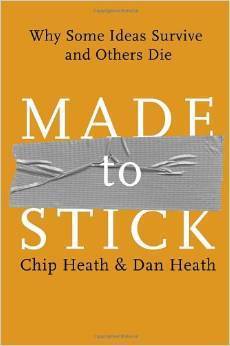 gly cover fool you. This is a great book if you want to become better at speaking or writing. It teaches you to think in terms of the framework “SUCCES”, which stands for:
gly cover fool you. This is a great book if you want to become better at speaking or writing. It teaches you to think in terms of the framework “SUCCES”, which stands for:
Simple = Strive for simplicity, less is more.
Unexpected = The funniest jokes have an unexpected or open-ended finish. They “break” your pattern recognition.
Credible = Back up your claims with proof, statistics, quotes, and so on.
Concrete = Use comparisons to make people understand advanced concepts. Tap into their existing mental schemas.
Emotional = Engage emotions. Preferably through stories.
Story = Stories are easy to remember because the human brain has evolved with spoken word as the primary tool for transmitting information.
If you follow the ideas in this book your ideas, in text or speech, will have a higher chance of “sticking” in the minds of other people.
Critical Path
 Critical Path
Critical PathCritical Path
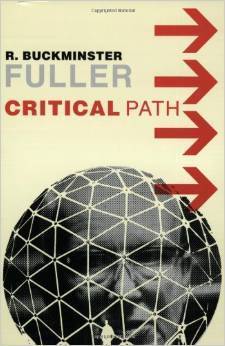 The first half of this book deals with Fuller’s view on the evolution of mankind and its political rule up to present day [1980s]. This is followed by a large chapter on his personal philosophy. The second part of the book is about the critical path (the fastest way to finish a project) of how to”make man a success in the universe” by working together to get off “spaceship Earth” (Fuller regarded our planet as a spaceship).
The first half of this book deals with Fuller’s view on the evolution of mankind and its political rule up to present day [1980s]. This is followed by a large chapter on his personal philosophy. The second part of the book is about the critical path (the fastest way to finish a project) of how to”make man a success in the universe” by working together to get off “spaceship Earth” (Fuller regarded our planet as a spaceship).
Buckminster Fuller was the first singularity spokesperson, only he didn’t call it that. He called it ephemeralization (doing more with less). Moore’s Law, The Law of Accelerating Returns and other such ideas stem from ephemeralization.
Those in supreme power politically and economically as of 1980 are as yet convinced that our planet Earth has nowhere nearly enough life support for all humanity. All books on economics have only one basic tenet—the fundamental scarcity of life support. The supreme political and economic powers as yet assume that it has to be either you or me. Not enough for both
Fuller spent his life proving this was false. His ideological nemesis was Thomas Malthus, who wrote An Essay on the Principle of Population in 1798 and produced the idea of scarcity-thinking, which still lives on today.
Fuller was one of the smartest men of the 20th century — and you’d be a fool if you didn’t learn from him. But he is a bit tricky to understand. He likes to write extremely long sentences and use words he himself made up. Reason being that he “preferred to not be understood rather than misunderstood”.
Have you read any of these books, and if so, what did you think?
Have you any recommendations of your own? Share it below.
Want more book recommendations?
Check out my first edition of “23 Excellent Books You Should Read“
The post Another 23 Excellent Books You Should Read appeared first on Startgainingmomentum.
October 30, 2014
Think Like an Investor: Why Rationality Trumps High IQ

I was watching a video on YouTube of Warren Buffet giving a speech and I saw this comment.
It made me snicker.
Yes. It’s easy to be a smart-ass in hindsight.
But it’s hard to be smart — and put your resources where your mouth is — when it actually matters.
In the last part I told you about the hedge fund with the ironic name, Long-Term Capital Management (LTCM), and how they suddenly went bankrupt by taking unnecessary risk. . .
Unnecessary as in risking what they needed to get what they did NOT need.
But again, it’s easy to be smart in hindsight.
Put yourself in their shoes: you’ve got two Nobel Prize winners and some of the smartest and most successful people in the financial industry. Confidence must be sky-high. And why shouldn’t it be?
–They had made a killing for three years straight. They were expecting business as usual.
Only it didn’t go that way — and they lost everything they had.
Why did they take such a foolishly large amount of risk?
Because their brains got warped by cognitive biases.
Despite the fact that they were all incredibly intellectually intelligent with high IQ, they still made obvious mistakes in their decision-making. Certain psychological influences turned their brains to mush.
In one of Warren Buffett’s speeches (not the one I got the image above from) he gives an illustrating explanation of this:
I always look at IQ and talent as representing the horsepower of the motor. But then in terms of output – the efficiency with which the motor works – that depends on rationality. Because a lot of people start out with 400 horsepower motors and get 100 horsepower of output. But it’s way better to have a 200 horsepower motor and get it all into output.
The leadership of LTCM probably had 400 horsepower motors, but how much was converted to output?
Their high IQ did not protect them from being negatively influenced by psychological factors such as:
Greed
Group think
Commitment bias
Assuming the future would be similar to the past (and that their money-making strategy would keep working)
False sense of security due to overconfidence, which caused them to underestimate the risk
And mistakes like these don’t just happen in finance.
They happen EVERYWHERE.
But LTCM actually made another mistake, other than risking what they needed for what they did NOT need. What am I talking about?
It’s that they also made a terrible decision in terms of. . .
. . . Life quality.
The potential loss of ruining their reputations and losing their clients’ money FAR outweigh the potential gain in life quality by earning a bit more money.
Let me explain.
You Should Focus on High ROI-Activities (Important Stuff)
When you set a goal you want to figure out your ideal situation. What is the best-case scenario for what you’re working on?
You know, the sweet spot where you don’t have much more to gain — in terms of life quality and improving your life — from taking extra risk and putting in more time, money or effort into the thing.
When you get to that sweet spot you want to stay there by playing the loser’s game (avoiding mistakes and unnecessary risks).
Then you shift your time and focus to improving some other area of your life where there is a higher return on investment (ROI).
Here’s how it works in theory:
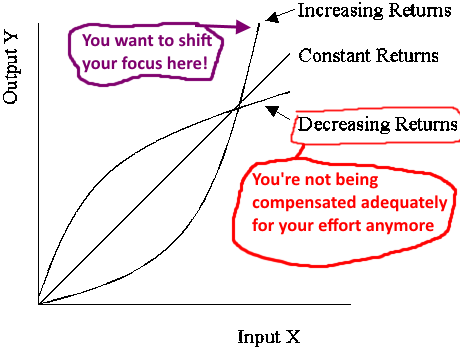
Because it does not make sense to take risks or spend lots of time and effort on something that is not going to improve your life in proportion to the work you put in.
And that’s exactly where you’re at once you reach a point of decreasing returns to scale.
What the guys at LTCM did does not make sense, logically speaking.
Only they weren’t thinking logically.
And they’re far from being the only rich and high IQ people to lose track of what matters and forget to maximize life quality.
In his autobiography, How%20to Get Rich: One of the World">How to Get Rich, billionaire Felix Dennis writes how he screwed up in a similar way:
Like an old, punch-drunk boxer, I couldn’t quit. I always craved just one more massive payday. One more appearance under the lights with the roar of the crowd and the stink of the sawdust and leather. One more fight. “I can take this young punk. I know I can. Just this once, so I can go out as a winner. So I can retire as the champ. Then I’ll retire. Just this last one.”
Sounds to me like a combination of greed , commitment bias and the winner effect. What do you think?
He continues:
Up to just seven years ago I was still working twelve to sixteen hours a day making money. With hundreds of millions of dollars in assets I just could not let go. Like I said, it was pathetic. Because whoever dies with the most toys doesn’t win. Real winners are people who know their limits and respect them.
[Interesting aside: I actually tried getting in touch with Felix Dennis after I read his book. But I wasn't successful. Now that I look him up on Wikipedia, I see that he died (from throat cancer) just a few weeks after I made contact. No wonder I never got a reply.]
In Felix Dennis’s case, the ROI — in terms of life quality — isn’t maximized by earning more money. He says said it himself. He should’ve quit earlier and spent his time focusing on poetry instead, which was his biggest hobby.
How to Choose Your Next “Investment”
Here’s how I see it:
First you set a big goal and do the planning (as you go).
Then you do the things you need to do to reach your goals.
And then you do those things some more (because nothing good comes easy).
You put in the time, the effort and you do the work.
As a result of this you get yourself addicted to these activities so that they become your “passion”.
You go through trial and error and learn from the mistakes you cannot avoid.
Then you reach your goal (maybe you make a pile of money?).
Finally, Once you’ve reached your destination, your ideal scenario, you need the clarity of mind and the strength of character to:
Maintain your sweet spot position
Or quit what you’re doing and change direction
But it won’t be easy — because you have so much momentum going for you to continue in this direction (homeostasis wants to remain intact).
Changing what you’re doing and investing into another area of your life, with a higher ROI, will be a challenge. Because you probably won’t be thinking logically about it.
And as Warren Buffett says. . .
. . . Even if you have a strong motor it doesn’t matter unless you can get it to function at maximum output.
Even if you have all the IQ in the world it doesn’t matter unless you can remain rational and accurately evaluate the situation.
Therefore changing direction is hard and takes a lot of energy.
Especially when you’ve committed a lot to the process.
Both mentally and physically speaking.
That’s why Felix was addicted to working and didn’t want to stop, despite the fact that he logically knew he didn’t have much to gain in terms of increased life quality.
That’s why those high-IQ guys at LTCM didn’t want to stop either. They liked the direction they were headed so much that they didn’t mind driving off the road.
Do you have what it takes to change direction?
The post Think Like an Investor: Why Rationality Trumps High IQ appeared first on Startgainingmomentum.
October 19, 2014
Think Like an Investor: Avoid Mistakes (and why you should play the loser’s game)
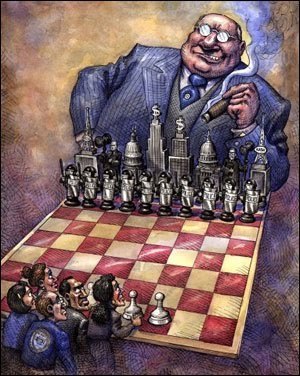
“An investor needs to make very few things right as long as he avoids big mistakes.”
–Warren Buffett
Charles Ellis wrote the now famous essay The Loser’s Game in 1946. In it, he compares sports — tennis in particular — to investing.
Ellis makes the distinction between a “loser’s game” and a “winner’s game”. In tennis it looks something like this. . .
Winner’s game
Played by professional tennis players.
The way to score — and win — is by hitting that special serve you’ve been working on for so long. Or by hitting that power shot that can only be used when the timing is perfect.
Loser’s game
Played by everyone who’s not a professional tennis player.
The way to score — and win — is by keeping the ball in play and not taking any unnecessary risks. Just focus on avoiding mistakes and you’ll be fine. Don’t give your opponent any easy points, for example by giving him the chance to smash.
These two styles rely on completely different strategies.
The winner’s game is about hitting fancy moves, mastering timing, outsmarting your opponent and taking risks.
The loser’s game is about sticking to fundamentals, avoiding mistakes and minimizing unnecessary risks.
However, investing is more complicated than sports. Success in life is also more complex (and less predictable) than sports are. . .
. . . But the analogy still holds true.
So, which of these two strategies is it most important that you use in your own life?
You guessed it: The loser’s game.
Even if it’s tempting to play the winner’s game, you should only play it in those rare circumstances when you’re actually the pro. Usually you’re not the pro.
Yet most people think they are.
–And so, they end up doing stupid things because they overestimate their own skill or intelligence. They suffer from inflated egos.
To be able to outperform the market you must be able to outthink the consensus. Are you capable of doing so? What makes you think so?
–Howard Marks, The Most Important Thing Illuminated: Uncommon Sense for the Thoughtful Investor (Columbia Business School Publishing)
The Most Important Thing
If you’re going to outthink the consensus you have to be above average — and that doesn’t just go for investing. That goes for anything.
There have been all sorts of research on this, and the general conclusion is that: Most people think they’re above average at just about everything.
There’s a famous study done in Sweden (of all places!) that asked people whether they believed they were better than average at driving. What were the results?
About 90 % of the people asked believed they were better than average drivers.
Obviously this cannot be true, as only 49 % of people can be above average. This cognitive bias of overestimating your own abilities is sometimes called excessive self-regard tendency.
Then there was a test that was done twice, first in 1945 and then in 2003. It asked “are you an important person?” In the first instance 2 out of 10 respondents answered “Yes, I’m an important person”. The second time, in 2003, 6 out of 10 respondents answered the same. The evidence is in. . .
. . . We live in a society with a lot of ego-deluded people.
There’s a saying in poker, I’m sure you’ve heard it:
If you can’t spot the sucker at the table, then guess what? You’re the sucker.
In life, whenever you cannot spot the sucker you should assume you’re it, and:
Hold on dearly to your money and get out of there ASAP, or
Play for fun and set a clear limit to your commitment of resources and when you’ll quit (like a rich guy in Vegas)
If you must play, you should play the loser’s game (and avoid mistakes)
Yet, because of excessive self-regard tendency, most people won’t do any of these things. They’ll play the winner’s game instead.
This is because think they’re better than they really are, even though they don’t have any solid experience to base that belief on.
I know what you’re thinking:
How can they be so incompetent?
– Because the more incompetent someone is, the less likely they are to realize how incompetent they are.
And vice versa: The more you know, the more likely you are to realize how much more there is to know, or how limited your knowledge on a topic is. Intelligent people know their limitations.
Overestimating what you’re capable of knowing or doing can be extremely dangerous–in brain surgery, trans-ocean racing or investing.
–Howard Marks, The Most Important Thing Illuminated: Uncommon Sense for the Thoughtful Investor (Columbia Business School Publishing)
The Most Important Thing
You should only play the winner’s game when you can easily spot the sucker.
However. . .
Not All Pros Play the Winner’s Game
Not even in professional sports:
Ted Williams is the only baseball player who had a .400 single-season hitting record in the last seven decades. In the Science of Hitting, he explained his technique. He divided the strike zone into seventy-seven cells, each representing the size of a baseball. He would insist on swinging only at balls in his ‘best’ cells, even at the risk of striking out, because reaching for the ‘worst’ spots would seriously reduce his chances of success.
And some of the best investors — Like Warren Buffett — don’t do it either:
As a securities investor, you can watch all sorts of business propositions in the form of security prices thrown at you all the time. For the most part, you don’t have to do a thing other than be amused. Once in a while, you will find a ‘fat pitch’ that is slow, straight, and right in the middle of your sweet spot. Then you swing hard. This way, no matter what natural ability you start with, you will substantially increase your hitting average. One common problem for investors is that they tend to swing too often.
–Peter Bevelin, Seeking Wisdom: From Darwin to Munger, 3rd Edition
Seeking Wisdom
According to Ellis, here’s what you must do to win the loser’s game:
For those who are determined to try to win the Loser’s Game, however, there are a few specific things they might consider. First, be sure you are playing your own game. Know your policies very well and play according to them all the time.
You have to stick to the system you have cleverly devised.
Otherwise you will get swept up in somebody else’s system.
Warren Buffett tells a story of how his mentor Benjamin Graham taught him to stick with what he knew best:
“He gave us a quiz,” Buffett said, “A true-false quiz. And there were all these guys who were very smart. He [Graham] told us ahead of time that half were true and half were false. There were 20 questions. Most of us got less than 10 right. If we’d marked every one true or every one false, we would have gotten 10 right.”
Graham made up the deceptively simple historical puzzler himself, Buffett explained. “It was to illustrate a point, that the smart fellow kind of rigs the game. It was 1968, when all this phony accounting was going on. You’d think you could profit from it by riding along on the coattails, but (the quiz) was to illustrate that if you tried to play the other guy’s game, it was not easy to do.
The moral of this story is. . .
. . . Don’t participate in competitions where you’re not the one making the rules.
It will leave you exposed to unnecessary mistakes.
Yet, lots of normal — non-professional — people believe they can outsmart the stock market and speculate over the short-term. What makes them think they can do this?
Do they have inside info?
Do they have a ton of capital?
Are they dealing with a business in an industry where they’re supremely knowledgeable?
–Nope.
They just think they’re smart. And when things — for some weird reason — go poorly and they lose their money, they blame it on bad luck.
They’re foolishly playing the winner’s game, and they’ll get slaughtered for it.
What they should do is to focus on. . .
. . . Avoiding Mistakes And Minimizing Stupidity
Because as Charlie Munger (Warren Buffett’s business partner and possibly the smartest man on the planet) says:
A lot of success in life and success in business comes from knowing what you really want to avoid — like early death and a bad marriage.
And. . .
It is remarkable how much long-term advantage people like us have gotten by trying to be consistently “not stupid”, instead of trying to be very intelligent.
If you want to be successful, and you have a long-term oriented outlook, there are some basic — yet very serious — things you want to stay the heck away from. You want to avoid things like:
Marrying the wrong partner
–By not settling for the first person who comes along.
Getting into business with a loser (someone that cannot be trusted)
–By checking their track record and judging their character accurately.
Getting addicted to (heavy) drugs
–By not doing them, obviously.
Getting fat and addicted to sugar
–By having a healthy diet.
Getting sick and unhealthy
–By working out and getting a good physique early in life.
Getting into debt
–By not buying things you don’t need, and never buying anything on credit (I’ve never understood how people can do this).
Associating with criminals and stupid people
–By not living in the ghetto, not hanging out where low-lives meet, or by politely ignoring them.
(What other things do you want to avoid in life?)
The point is for you to think of some worst-case scenarios and make sure that they NEVER happen.
When it comes to avoiding mistakes and minimizing stupidity, your best strategy is prevention.
“What the wise man does in the beginning, the fool does in the end.”
The best practical method for prevention is to. . .
. . .Figure Out the Root Cause And Solve it!
Have you got a problem?
General problems — the type that happen often — are the ones that it’s most important you solve.
But first you have to find the problem and know when it happens.
There are two smart ways to FIND general problems:
Write down daily lessons (make a section in your commonplace)
Ask “Why” five time
Daily lessons:
–You write down a few noteworthy things each day. Once a month (or at some other interval) you go through all the notes. Chances are you’ll find that you’re having a problem that’s happening over and over.
Here’s an example from my “daily lessons” section. Notice the bolded part in the top of the screenshot. That’s the solution.
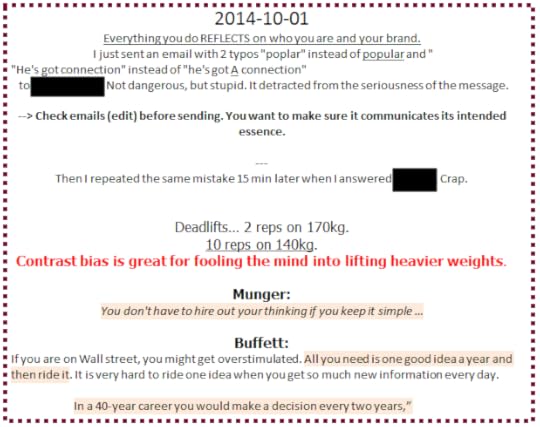
Now I have to figure out the root cause and find a way to prevent it by. . .
. . . Asking “why?” x 5:
Example of mistake: “I sent an email with typos in it.”
Why?
–Because I was distracted.
Why?
–Because my concentration was weak.
Why?
–Because I was mentally fatigued from not having taken a break in over four hours.
Why?
–Because I thought I was being efficient.
Why [did you think you were being efficient]?
–Because I was putting in time.
Boom.
This misunderstanding — mistaking time for efficiency — is the root cause for the mistake. I will take more short restorative breaks to prevent it from happening again.
Sometimes you need to go even deeper and ask why more times. But usually five times is enough.
Why Smart People Do Dumb Things
Are stupid people the only ones who do dumb things or make big mistakes?
No.
Even some of the smartest people in the world make huge mistakes. Roger Lowenstein tells the cautionary tale of how the hedge fund Long-Term Capital Management failed in his book When Genius Failed.
What is Long-Term Capital Management?
I’ll let Wikipedia answer that:
“LTCM was founded in 1994 by John W. Meriwether, the former vice-chairman and head of bond trading at Salomon Brothers. Members of LTCM’s board of directors included Myron S. Scholes and Robert C. Merton, who shared the 1997 Nobel Memorial Prize in Economic Sciences for a “new method to determine the value of derivatives“. Initially successful with annualized return of over 21% (after fees) in its first year, 43% in the second year and 41% in the third year, in 1998 it lost $4.6 billion in less than four months.“
In short: LTCM consisted of a group of incredibly intelligent people who all had brilliant track records. They made money by arbitraging (profiting on price differences) based on mathematical models. At one point, Institutional Investor called them “the best finance faculty in the world”.
Warren Buffett gives his take on how remarkable the failure of LTCM was:
The whole story of Long-Term Capital is fascinating. Because if you take Eric Rosefelt, Larry Hilibrand, Grek Hawkins, Victor Hagani, the two Nobel Prize winners: Merton and Scholes. . . If you take the 16 of them, they probably have as high an average IQ as any 16 people working together in one business in the country. Including at Microsoft, or whatever business you want to name. So you have an INCREDIBLE amount of intellect in that room.
Now, you combine that with the fact that those 16 had EXTENSIVE experience in the field they were operating. These were not a bunch of guys who’d made their money selling men’s clothing and all of a sudden got into the securities business. They had an aggregate of probably 350-400 years of experience doing exactly what they were doing.
And then you throw in the third factor — that most of them had nearly all of their very substantial net worths in the business. So, they had their own money up.
Hundreds and hundreds of millions of dollars of their own money up, super high intellect, and working in a field they knew. . . And essentially, they went broke.
–So they had a lot of incentives acting in their favor, which should have motivated them to act intelligently.
But it didn’t.
And the underlying reason why they lost everything is because they. . .
. . . Risked what they needed to get what they did NOT need.
They wanted to make a little bit more money than they were already making. So they risked their reputations, their own money, and most importantly: The funds of their investors. . .
. . . And lost it all!
The potential profit was clearly NOT compensatory to the potential losses they might suffer.
But they went ahead and did it anyway.
And — Nobel Prize winner or not — if you risk something that is important to you, for something that is UNIMPORTANT to you, then you are a fool.
How to Make Fewer Stupid Mistakes in Life:
When you’re a pro — and you can clearly spot the suckers — you should play the winner’s game. It makes sense to take calculated risks and to use your fancy moves if the odds are in your favor. For example, when the game is rigged to your advantage.
When you’re not the pro — and you usually aren’t (!) — you should play the loser’s game. That means you want to stick to the fundamentals, avoid mistakes and minimize stupidity.
Key Strategies to Avoid Mistakes:
Figure out the root cause by asking why (x5) and solving the problem.
Figure out some worst-case scenarios in different areas of your life and make damn sure those things never happen.
Never risk what you have and NEED for what you don’t have and DON’T need.
Learn from the example of Long-Term Capital Management (ironic name, huh?). Even Nobel Prize winners make stupid mistakes — especially when they don’t stick to a set of core principles.
Photo credit:
The post Think Like an Investor: Avoid Mistakes (and why you should play the loser’s game) appeared first on Startgainingmomentum.
October 9, 2014
Think Like an Investor: Create Your System

Today I saw an old man walking with a stroller.
He must’ve been 90-100 years old.
He was dressed sharp, wearing a suit and tie, a hat, and shiny shoes.
I observed him from a distance. He took 5-10 steps at a time before stopping to rest. When he had to pull his stroller down the curb it required tremendous effort.
Then he slowly crossed the street in the same way he had got there, by pausing intermittently. Making slow and steady progress in a pace suitable to him. Finally he arrived on the other side of the street.
He scaled the curb with his stroller, and you could tell he was completely focused on the task, exerting much willpower.
My instinctive reaction was to go and help him, but I didn’t. Because I realized that. . .
. . . This is a man on a mission. This is a man of character, a man of virtue; a man who fights his own battles, and for me to interfere would be an inexcusable insult to his pride.
Just the way I don’t want to be interrupted when I’m in flow, or about to break a record in the gym, this old man clearly didn’t want to be interrupted during his walking session.
Then I saw another man passing him. This man was at least 20 years younger and he had one of those electric wheelchairs. He wore a dirty jacket and a kid’s cap. He was followed by a middle-aged woman, probably a relative or some sort of nurse.
This was a weak man.
The difference between these two men is that the older man has a daily routine in which he takes great pride, and challenges himself. It matters enough to him that he will dress up for the occasion. This daily routine was clearly part of a larger system – a system he has probably stuck to for a long time. . .
. . . Whereas the younger (less old) man has no system at all.
His days aren’t aimed towards any purpose whatsoever. He has neglected his willpower and turned soft. Now he’s paying the price — rolling around in his electric wheelchair like a dirty corpse.
The old man with the stroller is the sort of man I want to be when I am 100 years old. The second man disgusts me.
You need to be like the old man:
You Need a System
And you need to start thinking like an investor.
Because you are one, even if you don’t think of yourself that way yet.
You may not have huge sums of money to place in the financial market — yet — but you’re still investing other resources; such as your time and energy.
Your are making investment decisions when you decide what university to attend, what job to get, the people you spend time with and associate with, as well as the skills you choose to practice.
Now, let me ask you:
Do you know the difference between an intelligent investor and an unintelligent investor?
Is it that only intelligent investors make money and become successful?
Not necessarily.
Over the short-term – a few years — it’s very hard to tell whether an investor is intelligent or if he’s just lucky. Warren Buffett shares a good story on the topic:
I would like you to imagine a national coin-flipping contest. Let’s assume we get 225 million Americans up tomorrow morning and we ask them all to wager a dollar. They go out in the morning at sunrise, and they all call the flip of a coin. If they call correctly, they win a dollar from those who called wrong. Each day the losers drop out, and on the next day the stakes build as all previous winnings are put on the line. After ten flips on ten mornings, there will be approximately 220,000 people in the United States who have correctly called ten flips in a row. They each will have won a little over $1,000.
Now this group will probably start getting a little puffed up about this, human nature being what it is. They may try to be modest, but at cocktail parties they will occasionally admit to attractive members of the opposite sex what their technique is, and what marvellous insights they bring to the field of flipping.
Assuming that the winners are getting the appropriate rewards from the losers, in another ten days we will have 215 people who have successfully called their coin flips 20 times in a row and who, by this exercise, each have turned one dollar into a little over $1 million. $225 million would have been lost, $225 million would have been won.
By then, this group will really lose their heads. They will probably write books on “How I turned a Dollar into a Million in Twenty Days Working Thirty Seconds a Morning.” Worse yet, they’ll probably start jetting around the country attending seminars on efficient coin-flipping and tackling skeptical professors with, ” If it can’t be done, why are there 215 of us?”
By then some business school professor will probably be rude enough to bring up the fact that if 225 million orangutans had engaged in a similar exercise, the results would be much the same – 215 egotistical orangutans with 20 straight winning flips.
The moral of the story is that it’s easy to get “fooled by randomness” and mistake luck for skill.
But over the long-term — 10 years — it becomes easier to tell who’s intelligent and who’s not.
The intelligent investors are more consistent in finding valuable investments, whereas the not-so-intelligent investors — who were lucky — regress to the mean, or achieve poor results. The main difference between the two is that. . .
. . .Intelligent investors have a system.
And they have strict guidelines for how much risk they’re willing to take.
That’s the difference.
Intelligent investors rely less on luck and more on. . . Intelligence.
That’s interesting. But how does that help me?
Well, as you are about to find out, investment philosophy is extremely applicable self-development and success in life, because it’s based on how to think better than other people.
If you can create a system for yourself and break it down to a consistent process, then — like the intelligent investor — you’ll probably be successful over the long-term.
But the system needs to be tailor-made to you. It should involve the following factors:
Your model of the future
Your risk-appetite
Your strengths
Your goals
Your process
Your short-term and long-term strategies
Your daily routine
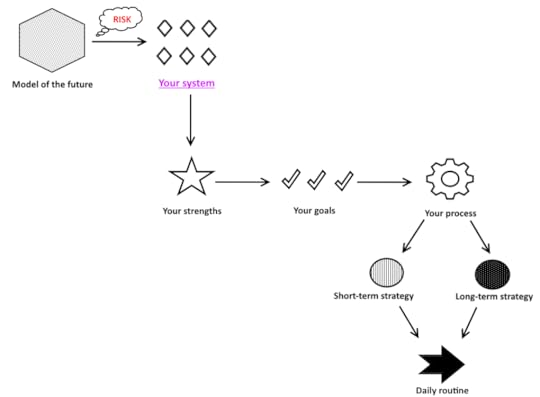
Let’s talk a bit more about each of these components.
Your model of the future
How do you think the future is going to turn out to be?
Most people either think nothing at all about it or they’re too opinionated. And usually they cannot base their opinions on anything solid. You don’t want to be like most people.
You want to learn from smart people and read quality books. That will give you a decent idea of how:
Things look like right now
And how the future may turn out
No one really successful — and I’m talking about guys like Arnold, Napoleon or Caesar – got that way by following herd behavior. They predicted a certain future and then they bet heavily on that scenario. . .
–And not just once. They did it repeatedly. That’s why we know their names.
The bottom line is this: making predictions about the future and positioning yourself to profitably always involves an element of. . .
Risk
And risk is best explained by the term “shit happens”.
The big difference between probability and outcome is that probable things fail to happen while improbable things do happen — all the time.
–Howard Marks
. . . And this is why it’s hard to tell what’s luck versus what’s not over a short timespan. Skill and intelligence first become evident over a longer period of time.
When you read enough stuff — and study history — you realize that there have been lots of schmucks and scammers who fooled people for years, like Bernie Madoff for example.
No one can predict the future perfectly and nothing is ever certain. Everything involves some degree of risk. The question to ask is:
How much risk am I willing to take?
That’s a personal question — I can’t answer that for you.
But there are four basic things you should know about risk:
1) Most people have a skewed understanding of risk due to mainstream media brainwashing and lack of education. (They believe sharks, earthquakes and terrorists pose a bigger risk to their lives than obesity, cancer, or car crashes)
2) Most people are by nature risk averse. There’s not necessarily anything wrong with that. But you need to figure out whether this is true of you or not — you must “know thyself“.
3) Most people either take too little risk or they (foolishly) take too much of it without adequate compensation.
4) Without risk there can be no reward. If people understood this, they wouldn’t fall for absolute returns of 8-11 % (like Madoff promised).
And one last principle: At the end of the day you tend to. . .
5) . . . put your money resources where your mouth is.
But you shouldn’t take any big risks, or try to predict the future, unless it’s related to. . .
Your strengths
Which, hopefully, is what you do for a living.
Or what you spend most of your time doing.
Or an area where you:
Have expertise and
Inside information.
Your strengths (and interests) are where you should invest most of your time and effort, and it’s where you should have your most ambitious goals.
Your goals
What do you want to accomplish?
There are two types of goals:
Short-term goals and long-term goals.
Set short and “easy” goals to aim for each week or month to boost your self-esteem and put yourself on the right track.
As for longer goals, I set 18-month goals.
I learned this from reading books by Peter Drucker. The reason to use 18-month goals is because it’s hard for the mind to specify and clarify the a goal that’s longer than that.
You achieve your goals through. . .
Your process
Success is NOT an event, it is a process.
Success cannot be attributed to one thing, it’s the combinatorial effect of doing a bunch of things the right way consistently over a long period of time.
Sometimes you get lucky. Usually you don’t.
But in either case you shouldn’t care. When you know you’re doing the right thing — and that your system works — just stick to it. Disregard short-term results and focus on the process.
Your process will change from time to time based on. . .
Your short-term and long-term strategies
The Wikipedia definition of a strategy is:
A high level plan to achieve one or more goals under conditions of uncertainty.
As you see, the strategy as to take into account your goals and your willingness to take risk.
Your strategy determines how you use your resources. Your main resources are your time, energy, and money. But there are many other resources — notably so your social network. A lot of people forget that.
Most (young) people are too focused on short-term strategies, because they want to make quick money.
But what they don’t realize is that most short-term strategies — especially those that have to do with making money — come with high risk. . .
. . . Meaning, you may end up with nothing.
That doesn’t mean short-term strategies are bad.
But it’s usually a bad idea to allocate all of your resources to a short-term strategy.
I prefer to spend most of my time on long-term strategies. This is a more sustainable approach to success. It ensures that I incrementally get a bit smarter, stronger, healthier; and that I associate with more intelligent and successful people as time goes by.
It’s more reliable to stick to a long-term strategy. But most people don’t do it because it’s less popular, less flashy, and it offers less ego-gratification. Another general truth about short-term strategies is that. . .
. . . They’re usually based on trends.
This is why lots of people:
Yo-yo diet
Invest in trendy businesses
Create websites full of affiliate links and ads
Finally, you need to figure out how to break down your strategies to a daily routine.
Your daily routine
When I saw the old man with the stroller I was probably seeing him during the hardest part of his daily routine.
And a daily routine should be hard — it should harden you.
It should bring you closer to your goals.
And your most ambitious goals should:
Stem from your model of the future
Involve an acceptable element of risk
Be based on your strengths
Be distilled down to short & long-term strategies for how to use your resources
Here’s. . .
How Your System Plays Into Your Decision-Making
Before I learn a thing, try something new, or start to consistently do a thing, I always think:
How do I incorporate this into my system?
Where does it fit in given my long-term goals?
Is this a short-term strategy to help me achieve some near-future milestone?
Or. . .
Is this a long-term strategy which I need to stick to indefinitely before seeing visible results?
As far as growth, long-term thinking, and improvement goes. . .
I think this way of doing things is becoming increasingly valuable for two reasons.
First, because of its cumulative effect as you grow older.
Second, because it’s not what the masses are doing.
And if everyone else is doing something you probably shouldn’t do it.
If everyone else wants to do something that means there’s a high demand.
And if everyone else can do something that means there’s a high supply.
This usually means there’s a low barrier of entry.
And if there’s a low barrier of entry, that means there’s going to be a lot of competition. And if there’s a lot of competition that means you can’t expect to make big profits and improve your status.
–And without those things you won’t be in a position of control and have the freedom to do as you wish.
This basic theory explains why there are a lot of people with shitty jobs in the public sector, a lot of people with shitty websites on the Internet, and a lot of semi-knowledgeable people regurgitating shitty information.
These things are the norm.
They’re average.
And you’ll inevitably be part of it unless you. . .
Create Your Own System for Success
Now. . .
. . . I don’t know how things will go for me over the next few months. I can’t predict what events will or won’t occur.
But I’m fine with that.
I can deal with that risk.
Because I have a lot of faith in my process, and where it’ll take me over the long-term.
My system-oriented approach may not grant me any overnight success. But it will grant me incremental improvement and harden me. Similar to coal being hardened over millennia while it’s pressed upon by its surroundings.
I don’t rely on luck or short-term thinking.
I don’t believe “tomorrow will be different” for me.
I know it won’t.
I don’t believe next year will be different for me either.
I know it will be.
Because I’m sticking to my system.
And you should too.
–And if you aren’t, why don’t you?
–And if you don’t have a system, create one.
The post Think Like an Investor: Create Your System appeared first on Startgainingmomentum.
September 26, 2014
How to Create Passion And Become Successful (but not at everything)
 I hung out with Mikael of AlwayBeBruceWayne a couple of days ago. We were discussing the topic of success, when Mikael said something smart.
I hung out with Mikael of AlwayBeBruceWayne a couple of days ago. We were discussing the topic of success, when Mikael said something smart.
He said that there’s usually an element of luck or randomness involved in success — especially meteoric success.
I agreed with this.
Mikael then said that when you try to decipher different factors in what made you (or someone else) successful at a thing, it’s hard not to let survival bias interfere.
Survival bias is a term that means you’re only paying attention to the things that lasted, and not to the things that perished. In this case: Only paying attention to the people who “made it” while disregarding all those who failed. And this often leads to inaccurate conclusions.
I agreed with him on this as well. . .
. . . And added that cognitive biases like hindsight bias and the curse of knowledge also make it challenging for successful people to decipher specifically what it was that made them so successful at what they did.
This means that some people who become very successful — and aren’t too analytical — have a tendency to oversimplify their success. They’ll say they’re successful specifically because:
–They’re “passionate”.
–It was “destiny” (biggest post-rationalization ever).
–It was “thanks to God” (U.S athletes always do this).

Mikael striking a Herculean pose.
And so on. . .
But as a matter of fact, their success may have been based on a completely different set of factors. The truth tends to be trickier than we think. Sometimes this post-rationalizing mental narrative that people tell themselves can even consist of complete falsities. . .
. . . And when very successful people spread falsities and inaccurate information it has harmful effects. Like when they tell young people that their success depended on being “passionate” (or some other vague and confusing reason).
Next thing you know there are headlines in major newspapers, TV, and forum posts on large websites about how “passion” is the key to becoming successful.
This takes me to the topic that I want to discuss with you today:
Because of this phenomenon, many young people believe that their life would be perfect if only they “found their passion”.
If only. . .
If only. . .
If only they “found their life purpose”.
I recently got an email from a young male reader about this.
Hi Ludvig,
I am confused because I don’t know what to do with my life.
All I know is that I want to have a successful career. I will have a degree in 1 year but I’m not looking forward to starting a career in what I’ve studied. And at the same time I don’t like university or think it’s very interesting, plus it costs me money I don’t have, so I will not study more after I finish.
I guess what I am really asking is: How do i find my life purpose?
I know I have to find my passion first before I can do that, but the problem is I don’t know what my passion is…
Don’t take this the wrong way, because I mean it in a good way, but you seem like you’re passionate. How did you get that way? Have you got any advice for me?
Thanks in advance
My answer to this email wound up getting long and detailed. So I decided to turn it into this article instead.
My answer below:
You know what you should do?
You should just forget it.
Seriously — rid yourself of the idea of a “life purpose”.
Because it’s only an idea. It doesn’t have any objective reality on its own, except for as long as you entertain it.
The idea of a “life purpose” has become a widespread meme in modern culture, which explains the popularity of articles about:
How to Find Your Life Purpose in 60 Seconds or Less
But consider the following. . .
If those articles delivered on their promise there would be a lot more people who had “found their purpose”, right? And if that were the case there would be some magic formula for how to do that by now.
But there aren’t — and there isn’t.
Maybe that’s because. . .
. . . There is no general — objective — life purpose which applies to everyone.
And so, naturally there’s no other person who can give you the right answer or tell you specifically what to do (not even a tarot reader, a numerologist, or a psychic).
In other words — you’re on your own.
You have to figure out this stuff for yourself.
But. . .
. . .Maybe I can nudge you in the right direction.
When it comes to answering tricky questions I like to see what older, smarter, and more experienced people (than myself) have said on the topic. People who have an enviable track record, with great results in some area of their lives that I would like to replicate.
Then, once I have gathered enough material, I will go through it all to see if it makes sense.
And as far as the “purpose & passion question” goes, there is no shortage of smart people who’ve contributed with their thoughts. Let’s go through a few of these people. Their opinions can be divided in two camps:
1) “Passion is bullshit.“
Versus
2) “Follow your passion.“
Let’s start with the “passion is bullshit” camp.
Scott Adams (Writer of Dilbert and serial entrepreneur):
When a successful person is interviewed, and you say, “What was the secret to your success?” what they can’t say, because society won’t let them, is: “I was smarter, I worked harder, I had better connections, and I got really lucky.” Instead, they go with a democratic trait: passion. Anyone can have passion in the right situation, so it makes it sound like you can do what they did.
And what does Adams think is a better idea for becoming successful than relying on “passion”?
One strategy for getting ahead is being incredibly good at a particular skill; you need to be world-class to stand out for that skill. In my case, I layered fairly average skills together until the combination became special. If you put me in a room with 20 people, I’m not going to be the funniest or the best artist, writer, or business person. Because I have all of these things in sufficient (but not world-class) quantity, it was the combination that made them successful.
So, if you studied engineering, you could probably be a good engineer. But if you studied engineering and took classes on public speaking, there’s a good chance you’ll be running the show. If you intelligently choose which skills to layer on top of each other, that’s an accessible strategy, whereas passion is complete misdirection.
I agree. What do you think?
And here’s why he thinks that physical health (and being fit) is also more important to success than “passion”:
My view is it’s not passion you want; it’s energy. It doesn’t matter what you’re doing, you need more energy to do it better. It’s your competitive edge, and it’s available to all. That stuff will protect you against your failures, as well as give you energy to try more things. So if the goal is to try more things until luck can find you, the place to start is your fitness.
I have taken a similar approach to Adams. I base my long-term decisions on 3 factors:
Will doing this free up more time?
Will doing this give me more energy?
Will doing this help me make more money?
When I first made up my mind to get in excellent physical shape some years ago, I made that decision from a long-term perspective. There were 3 main reasons why I was motivated to make it happen:
I knew I wasn’t going to have the time to do it when I was older
I knew I needed the extra energy
I knew that once you’re ripped it’s extremely easy to maintain. . .
So it was a no-brainer for me, and my motivation never faltered.
Next is M.J Demarco (serial entrepreneur and author)
In his book Millionaire Fastlane, Demarco writes about the idiocy of following your “passion” when the goal is to make money.
He gives the example of a guy whose passion was hip hop music, and decided to set up shop in the neighborhood he lived. The problem was that there was a demographic mismatch. Mostly elderly people lived in the neighborhood:
Is a 91-year-old grandpa the target market for hip-hop gear? The obvious problem here is selfishness. The owner is following his passions, and his love for hip-hop music and culture. Maybe a life coach told him to “do what you love.” Whatever the motive, the need is internal and not externally based on the marketplace.
Life coach? More like life couch.
And the finally we have. . .
Mark Cuban (billionaire entrepreneur)
Who gives — in my opinion — the best answer.
Here’s what Cuban says:
if you have been able to have some success, what was the key to the success? Was it the passion or the effort you put into your job or company ?
If you really want to know where your destiny lies, look at where you apply your time.
Time is the most valuable asset you don’t own. You may or may not realize it yet, but how you use or don’t use your time is going to be the best indication of where your future is going to take you .
Let me make this as clear as possible:
1. When you work hard at something you become good at it.
2. When you become good at doing something, you will enjoy it more .
3. When you enjoy doing something, there is a very good chance you will become passionate or more passionate about it.
4. When you are good at something, passionate, and work even harder to excel and be the best at it, good things happen.
Don’t follow your passions, follow your effort. It will lead you to your passions and to success, however you define it.
Reasons #2 and #3 are completely overlooked by “passion-seekers”. They don’t understand psychology. Because here’s the thing. . .
. . .You can trick your brain into liking almost anything as long as you don’t hate the thing to begin with.
You just need to be clever, consistent, and disciplined about it.
And you must want it. Otherwise you won’t be willing to put in the initial investment of:
Time and effort
Emotion
Money or some other form of kind of “sacrifice”
Because that’s what passion is made up of: Investment.
Passion is not some magical blessing bestowed upon a chosen few individuals who go holy pilgrimages to “find their purpose”.
Passion is about caring (giving a shit) about something, being curious, and being interested. And this won’t happen by itself. You must put in that period of initial investment — and immerse yourself.
If that’s too general for you, I’ll tell you one of my favorite strategies for creating “passion”. I call it:
The Immersion strategy:
And it works by creating lots of mental associations on a topic in a short period of time (like by studying the history of the topic).
If you can do that then you’ll create an interest. And if you keep it up and invest more into the process you’ll create a passion. I’ve done this with lots of things.
But most people don’t do this. They do the exact opposite: They just search and search, without ever immersing themselves in anything. . .
. . . And then they do more searching, because their searching has become habitual. If you ask them why they do this, they’ll tell you:
Because it still doesn’t feel perfect!
And supposedly it has to feel “perfect right from the start”. Otherwise it doesn’t count, and it’s not a “real passion”. That’s what they were told by the passion & purpose professionals.
These people are hopeless.
Now let’s go through the arguments for “following your passion”
–On second thought, let’s not.
I don’t even want to address them because they’re so wacky.
Lots of people, with no real track record to base their advice on, tell you to “go for your dreams”, “shoot for the stars”, “follow your heart”, and so on. It sounds nice –but it has zero practical value.
Instead, let’s discuss. . .
How to Have a Successful Career:
Here’s how I see it:
You must find your STRENGTHS (what you’re good at).
Then you must BUILD on your strengths.
And finally you must put yourself in the right situations where you’re likely to meet the right people.
If you can do those three things consistently you’ll improve your chances for serendipity enormously, and you’ll probably have a successful career over the long-term.
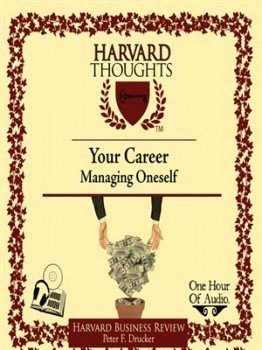
Excellent book. Only 13 pages. Right click the image, open in a new tab, and download for free.
You find your strengths slowly by reading and analyzing books, learning from experience, and by being around smart people. It may take a while.
I want you to read this (free) book – Managing Oneself by Peter Drucker — and take notes.
It’s only 13 pages.
But it’s very good.
Here are a few relevant excerpts.
Success in the knowledge economy comes to those who know themselves—their strengths, their values, and how they best perform
It takes far more energy and work to improve from incompetence to mediocrity than it takes to improve from first-rate performance to excellence.
(You can read my thoughts on this here: 9 Things You Must Know About Natural Talent to Succeed
The only way to discover your strengths is through feedback analysis.
And this is one of the reasons I write a lot and analyze what I do.
You should keep a journal and take notes before and after important decisions. Because it helps with two things:
1) It shows you how your thoughts are affected by different circumstances that arise.
For example, when you’re scared or desperate you tend to think shitty thoughts that have low long-term value. So never make important decisions when you’re emotional.
2) It matches your expectations of an outcome against the actual outcome in a way that is easy to compare
When practices consistently over time, this process of feedback analysis is the process by which you learn to “know thyself”.
Practiced consistently, this simple method will show you within a fairly short period of time, maybe two or three years, where your strengths lie—and this is the most important thing to know. The method will show you what you are doing or failing to do that deprives you of the full benefits of your strengths. It will show you where you are not particularly competent. And finally, it will show you where you have no strengths and cannot perform.
Two or three years!? But I want to find my passion now!
–Then I suggest your start writing.
Create a consistent process — and stick to it.
Stop searching and start immersing.
Successful careers are not planned. They develop when people are prepared for opportunities because they know their strengths, their method of work, and their values. Knowing where one belongs can transform an ordinary person—hardworking and competent but otherwise mediocre—into an outstanding performer.
Indeed — prepared being the key word.
For example, I know a guy who makes good money simply by the virtue of his people skills. He’s very good at making others around him feel comfortable . He knows he’s talented at this, so he made sure he took social jobs where he met lots of people.
This was a smart long-term strategy. Because it eventually allowed him to meet influential people who liked him, and recruited him for their new company.
Here’s what I’m guessing those guys thought when they hired him:
This young guy is great at hanging out with clients. Much better than we are. If we take him on, he can meet with clients, and we’ll have more time to manage the business.
My friend anticipated that something like this would happen sooner or later. Because he knew his strengths.
If you want to do the same thing then. . .
. . . You want to figure out the answer to questions like these:
How do I perform best?
Alone or in a team?
What are my strengths?
Where does success come naturally for you?
What are my weaknesses?
Where do you consistently fail?
How do I learn best?
Do you prefer reading or listening?
Do you learn best when you explain to someone else?
Do you learn best by applying what you learn?
–Personally, I learn from all these things about equal. So I have put together a framework for learning where I combine all these things. But some people are more extreme:
Churchill was an excellent listener.
Hitler liked giving monologues — he was a talker.
Eisenhower was a reader.
What are my values?
What will you stand for?
What will you not stand for?
After you figure that out you start working on the final question:
Given my strengths , my way of performing , and my values : How can I make the greatest contribution to what needs to be done?
Indeed, how?
A tip for answering tough questions:
When you start working — (yes, it takes time) — on these questions, a good idea is to begin by inverting. Turn each question on its head. For example, ask yourself: How do I perform horribly?
And then work by a process of elimination, until you know all the things you need to avoid to not perform horribly.
Summary: Stick to Actionable Advice
Passion?
Don’t believe the hype.
Life purpose?
Don’t buy into it.
You don’t find any of those two things.
You create them.
And how can you have a successful career?
By:
Finding out your strengths through feedback analysis
Then building on your strengths by engaging in deliberate practice
And combining that with putting yourself in the right situations with the right people
–And soon good things will happen. You should. . .
Do it even if it takes some time.
Do it even if most other people are only interested in taking shortcuts.
But. . .
Don’t do things just because everyone else is — that’s called conforming to herd mentality. . .
. . . And it’s a sure way to mediocrity.
All high performers take their time to find out what they do well and then they practice like hell to do those things swell.
Photo credit: Overdrive
The post How to Create Passion And Become Successful (but not at everything) appeared first on Startgainingmomentum.
September 11, 2014
2 Years of SGM (plus lots of insights and Q&A with readers)
 I’m pretty sure Michael The Situation Sorrentino from the “reality” show Jersey Shore is sitting in the seat in front of me. Or it could just be his Doppelganger.
I’m pretty sure Michael The Situation Sorrentino from the “reality” show Jersey Shore is sitting in the seat in front of me. Or it could just be his Doppelganger.
I’m writing this to you on a plane departing from New York to Stockholm, while listening to the song Molly by Le Matos (you can listen to it here).
The woman sitting next to me (now sleeping) is a marketing consultant who specializes in social media marketing. She just invited me to come to NYC.
During my previous transit, from Boston, two funny things happened.
First, I saw Mitt Romney.
He was walking with a well-dressed blonde woman by baggage claim. Then he went into the restroom, took a piss, and didn’t wash his hands (according to an acquaintance of mine who was in there).
Second, when I had a few hours to kill while waiting for my plane, I sat down to read. This is a smart habit. You should always carry a book and a pen with you so that you don’t miss out on learning.
After I’d read for a while I lost concentration and stopped. I then went into a book store and looked through their History, Biographies, Business, and Classics sections.
I spent the next 2 hours skimming 100+ books — that I narrowed down to 36 interesting books. Then I bought the 10 most important ones. I would’ve bought them all, but I wouldn’t have been able to bring them with me on the plane. I’m a frugal person. But not when it comes to books and learning.
So I asked the book store employees to stack up the books in piles on the counter.
After they’d done that I took pictures of all the books I didn’t buy, which I later filed into my commonplace section “Books to read”.
The book store employees thought this was really interesting, so they started asking me questions. They’d never seen anyone come into their store doing what I did. They wanted to take pictures of me taking pictures of the books. I told them, “go ahead”, so that’s what they did.
Here are the books (perhaps you’ve read some of them? If so, tell me what you learned.)



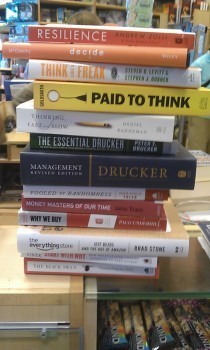
Then the manager of the store told me about her son-in-law, who happened to be a writer of relative fame. She thought I should contact him.
So I did that.
Lesson: Chance encounters happen often. ABP — Always Be Prepared. Be the vigilant hunter.
And speaking of buying or selecting books (or any other products for that matter). . .
. . . After you examine some of them and decide to buy — let’s say 3 of them — you’ll start acting irrationally. You’ll be inclined towards buying stuff you don’t need, just because you’re in a good physiological state.
This is because you’ve triggered your brain’s spreading activation, which makes you think about all the things you desire and other positive things like that.
When that happens all your positive associations start firing and you become overly focused on the positive.
Because of this, I asked myself: Do I really need this book? How will it be useful for me? Can I just Google this stuff later?
. . . And similar questions to bring me back to reason, and help filter out the books I didn’t really need. Before I did that there were more books than the ones you see above.
If you’re into retailing, neuroscience, or work with in-store marketing you probably knew this already. . .
. . . And ironically enough, one of the books I bought in the store was by Paco Underhill (a retailing-pioneer).
You also knew this if you read my free eBook: Overcoming Information Overload.
Now then — onwards to the topic of the day:
It’s Been 2 Years Since I First Started Gaining Momentum
. . . Back in September 2012.
The first year I just wrote for myself to improve accountability and get a feel for blogging. I knew it would be a valuable skill set no matter what I would pursue later.
And it turns out I was right in more than one way.
Here are a few benefits I can attribute directly to having started the site and adopted the SGM philosophy over the past 2 years:
I’ve become a lot more consistent and disciplined.
I’ve become more resourceful.
I’ve become better at organizing my thoughts, probably mostly thanks to the mad amount of writing I’ve done (most of it is not published).
I’ve connected with a lot of great people who I’ve learned a tremendous amount of cool stuff from.
I’ve got plenty first-hand experience of what online marketing is about.
Now, you’re probably wondering. . .
What is the future of SGM, what comes next?
You will just have to wait and see.
But I can tell you this much:
–A lot.
What you’re seeing right now is nothing compared to what SGM will be.
 And I know that. . .
And I know that. . .
SGM Will Keep Providing Value to Plenty of People
How do I know that?
Well, for starters, based off of tons of emails I receive.
Here are a few of them.

That email made my day, because it’s exactly what I want to do with the articles on SGM.
Here’s another one.

And a last one:
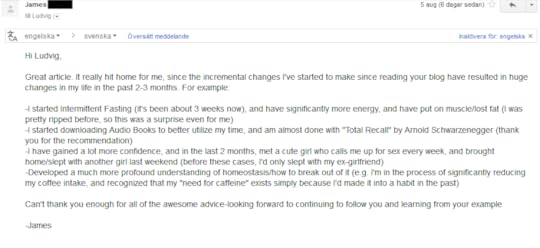
I really appreciate these emails. They let me know I’m on the right track, and that people understand what SGM is about.
That being said, let’s jump into some. . .
FAQ
Because there are certain types of questions I receive frequently via email.
I have articles in the works to respond to some of these questions, but for now I’ll just answer the most recurrent ones here.
Do you offer coaching / mentoring / Skype?
No.
Maybe I will do it in the future if I can find some scalable way of doing it.
However, I do read and answer all email I get.
If you send me an email I’ll always do my best to help you out, whether you have a question, want some advice, or just want to say hello.
I have a blog/website about [insert topic]. Can you help me out?
I often get emails from bloggers, people who make a living online, and various people who are trying to build a presence on the Internet.
And if I can, I like to help them out because:
I remember how hard and “lonely” it was when I first started out. I also know that most people quit because of the initial complexity and lack of encouragement. It’s hard in the beginning.
I’m selfishly hoping they’ll blow up, become successful, and that they will remember me later. This is known as “expanding your luck surface area” by helping as many people as you can. Here’s a guy who puts it well:
The amount of serendipity that will occur in your life, your Luck Surface Area, is directly proportional to the degree to which you do something you’re passionate about combined with the total number of people to whom this is effectively communicated
–Jason Roberts
Note:
If you’re just starting out with blogging or making a presence online, I’ve written two popular (and good) articles about that.
“How to Blast Out of Obscurity” On StartupBros
“How to Pitch Your Content to an Influencer” On Bold And Determined
They should help solve most of your initial problems. Don’t ask me unless you’ve read those articles.
Who is the typical SGM reader?
It’s hard to say.
Harder than you might expect.
My ideal reader is an ambitious young guy aged 15-30.
But from what I can tell there are all sorts of people who read SGM.
Both men and women.
People with high education. People that have successful careers and businesses. And people on the other end of the spectrum.
The common denominator seems to be a belief in never-ending self-development.
Here’s a really cool Swedish guy who reads SGM, and he has a very interesting site of his own. Make sure you check it out!
Another person who reads SGM is Charles Kirk. I know this because he linked to SGM in one of his financial reports and sent a bunch of visitor my way.
What is your most popular article?
It’s the one about how I got ripped in 2 years.
It’s gotten picked up by Google and gives me a bit of organic traffic (randomly found by people via search engines).
What drugs do you do — if any — and what is your opinion on drugs? Do you think they’re good or bad? Do you recommend nootropics?
I only consume caffeine (pills, coffee, and tea), alcohol in moderate use, and psychedelic drugs a few times per year (for self-development purposes).
What is my opinion of drugs? I think it’s extremely individual. Different drugs suit different people — it comes down to self-experimentation.
I used to smoke a fair amount of cannabis when I was younger, and I liked it. It helped me expand my thinking and it made me feel creative. . .
. . . Then suddenly, about 3 years ago, that changed overnight. Ever since that time cannabis has just slowed me down and made me feel congested. So I quit it.
When I was reading books about neurology and brain health I would find some science indicating that most drugs are bad for the brain over a long period of time. But the problem is that most of those studies are based on hardcore addicts and extreme users.
To my knowledge there aren’t many good studies on long-term moderate users.
And if you study some of the greatest men in history (thinkers especially) you’ll find that many of them were long-term users — and some even abusers — of various drugs. Guys like Einstein, Darwin, Hemingway, Gurdjieff, Nietzsche, Sartre, etc.,
I think that if a drug dramatically boosts your productivity, and helps you achieve your goal, it may be worth taking even if it’s moderately unhealthy.
And nootropics?
I have little experience with nootropics, so I have nothing to recommend.
I think I suffer from candida, and I read you had it and successfully cured yourself, how did you do that?
I will write a detailed article on this eventually. . .
. . . For now, all you need to know is that the few most important things I did was:
Doing longer periods of fasting (this is how I invented my 2-day fast)
Drinking 5 grams of L-glutamine each morning (and skipping breakfast)
Cutting out all sugar from my diet
Minimizing all carbs except broccoli and spinach
Eating a lot of high quality coconut fat before each meal, and plenty of it with each meal
These things took my gut health from awful to awesome during a period of 6+ months.
What is your political opinion?
I have a bunch of opinions.
But I will hold off from talking or writing about them for now. Maybe I will write an article on this eventually — not on my specific political opinions or beliefs, but on my general outlook regarding politics.
The reason I’m not going to go into details or specifics is not because I’m afraid of being persecuted or anything like that. It’s for pragmatic reasons. You see. . .
. . . When you put things on paper, for example by writing an article about something, you solidify your thoughts. You increase the likelihood of committing to a course of action.
And I don’t want to do this unless I’m certain about a thing.
And I’m not certain about politics.
I consider myself far too young to form an opinion about it. The Greeks and Romans had it right by instituting barriers to entry for political life, including an age limit for participation. And this is takes me to my main point.
You see, the brain doesn’t develop fully until you’re around 30-40. And if you’re a smart person you will respect this, and do your best to remain somewhat open-minded for as long as you can.
Because once you make a definite decision about a thing your mind closes itself off and your teachability goes down.
This makes your ability to learn things taper off for a number of reasons — notably so because of confirmation bias.
Someone who understood this well was Charles Darwin. After he had already spent many years coming up with his ideas about evolution he took another another 20+ years (!) before concluding that he was correct. During those years he read and studied counterarguments to his thesis and adapted his ideas to whatever feedback or resistance he was met with.
Does this have anything do with politics?
Yes it does.
Ideological beliefs — political and religious in particular — tend to be some of the most emotionally intensive beliefs. Hence, they are the hardest to change.
This is why there are so few intelligent and accomplished fundamentalists of any sort. Because of their strongly held ideological beliefs they fail at adapting to the marketplace, which is in a constant state of flux. Their belief system blocks them from learning useful things which may prove their beliefs wrong. . .
. . . And this limits their success.
Can you show your commonplacing system and how you use it for self-development? Can you show me all your categories and how you do things?
No, it would take too much time to explain all the categories.
I have gone through some of the fundamentals in my OneNote article.
And how do I use my commonplace for self-development?
To me self-development is the same thing as learning. And I use commonplacing to speed up my learning process. How do I do this?
–I do it based on a system I’ve created to induce deliberate repetition of the most important things I learn.
I then distill this information into best practices for different areas of my life that I’m focusing on. Then I make sure I review this quality information every once in a while to ensure it becomes part of my personality.
So, it’s a type of top-down information process, very much like my “book summary book” strategy, but on a larger scale.
Now, let’s jump into some detailed. . .
Reader Q&A
Below are a select few questions copied from the “reader content feedback” section of my commonplace (yes, I save this stuff).
If you have questions/suggestions I will remember it. And it may very well end up on the site someday.
Perhaps today. . .
Q:
I read about — and started — commonplacing but I have now stopped for the time being until I figure out this thing I’m about to ask you. You talk about the benefits of compartmentalizing your thoughts (you reference to Napoleon’s natural ability for doing this).
But I am in doubt because I recently read about compartmentalization on Wikipedia and (
see here
) I’m wondering if this might be harmful to me over the long-term because it doesn’t seem natural. It seems like an unnatural and unhealthy way of thinking. Maybe if you compartmentalize your thoughts too much you will get psychological problems or possibly alternative personalities?
For example I believe we should strive for unity of thought and not separation and that we shouldn’t divide things into categories like “good”, “bad”, “green”, “capitalism” and things like that. No, instead I think we shall try to see things as ONE whole (God) and accept things. Could you please tell me what you think?
A:
Ok. . .
. . . So Wikipedia says that compartmentalization is a way to dissolve cognitive dissonance. And cognitive dissonance is how we dissolve negative tension — through thinking — between our beliefs and the actions we take.
I think the problem here is that you are overestimating how much control you actually have.
Sure, you do have a bit of control over your conscious thinking. But you don’t have much control over the subconscious mechanisms that direct your thinking.
Such as the mechanism of cognitive dissonance.
Most of your thinking is actually directed towards the aim of reducing stress. And this isn’t something you can do away with. It’s just how the brain works.
This is not an inherently negative thing — it’s an evolutionary survival tactic.
You get a problem. . .
. . . And this problem puts you off balance and stresses you out in some way. Your brain then goes to work finding a solution by compartmentalizing and organizing its thoughts to do away with the stress through some action. This is going to happen regardless of whether you want it to or not.
And one more thing: You don’t want a totally stress-free life — and try to avoid cognitive dissonance — that’s how you become a weakling (both physically and mentally).
Now, let’s talk about commonplacing.
The practice of commonplacing is the most intelligent way I have found to speed up the process of compartmentalization.
Commonplacing helps you solve problems faster, gives you more ideas, and over time makes you “smarter” than normal people.
Finally, I think you’re misunderstanding another thing. Namely, the nature of thought.
When you’re talking about “seeing things as a whole”, unifying thought, and accepting what is. . . How do you think this happens?
It happens in your subconscious mind — not in your conscious mind.
Your conscious mind (thinking) is extremely inefficient, slow, and uneconomical in terms of energy — compared to your subconscious mind. The difference is staggering. The subconscious mind is thousands (possibly millions) of times faster.
In other words, you unify (synthesize) thoughts and solve problems with your subconscious mind. And this happens without your explicit knowledge or awareness. And it happens incrementally. This process is imperceptible for most people.
Perhaps you can notice this if you’re a person who has an extremely well-developed ability for meta cognition (observing your thinking and analyzing it on multiple levels).
Summary:
I believe:
You are overestimating how much “choice” and control you have over the subconscious mechanisms that direct your thinking.
That commonplacing is in fact very healthy and that it should be done by everybody.
That the subconscious mind is what “unifies” thought and solves problems. Not the conscious — thinking – mind. And the practice of commonplacing speeds up this subconscious process immensely.
Q:

A:
Ok, so the Planning Fallacy is basically that we overestimate our ability to follow through on the plans we make. This is often results in overly ambitious to-do lists or unrealistic goal-setting.
The planning fallacy is also the reason most business projects take longer and cost more than they’re supposed to according to initial projections.
. . . Which is why you should NEVER trust blindly in business projections or financial forecasts.
The planning fallacy is a BIG problem for most people. It makes them feel guilty for not being able to do all the things they (unrealistically) set out to do.
The planning fallacy is why most people are biased towards overestimating their productivity. And I am no different — I overestimate my productivity all the time. And. . .
. . . I hate it.
However, over the past year I’ve made promising improvement.
There are 3 things I do every day to battle this bias:
In the “journal section” of my commonplace I always do time-logging. (I learned this from reading Peter Drucker books)
In the top of my journal I always post a box of “to-do items” for the next day before going to bed
I select 1-3 of the most important things to do each day and finish them before diverting my attention
If I can do that, which I often can, then I will spend that day productively.
Here’s an image of how the time-logging in my commonplace “journal section” looks like:

Notice the red lines — indicating time of the day. This helps me in two ways:
It keeps tracks my activity
It keeps me accountable
[Note: If you want to read more about the planning fallacy, check out my friend Patrik's recent article. It's more informative, scientific, and thorough.]
Q:

A:
I have three ethical rules for my conduct on the Internet:
Don’t get involved in arguments or feed trolls/haters.
Don’t say anything you can’t — or won’t — stand for. Even on a forum.
The golden rule: Do unto others as you would have done unto you.
The reason I don’t use pop ups is because it really annoys me when I visit other sites that do use them. And I don’t want to annoy the people who visit SGM.
Maybe it will get me a bit higher conversions — probably.
But I’m not willing to do it if it’s in a tacky or obnoxious way.
Q:
I know what I should do, but I’m NOT doing it. And this isn’t just a one-time occurrence, it’s my daily reality. I don’t know what is wrong with me.
I KNOW I could do some great things if I just took action on my plans and ideas. But the problem is that — I don’t! To be honest with you I don’t know why. I’m just confused about it.
I guess what I’m asking here is: Do you ever feel this way, and if so, what do you do?
A:
Look. . .
. . . Everyone has that — to a varying degree.
You simply gotta deal with it.
If you don’t, it’ll cause problems — like it did for Germany and Russia when Hitler and Stalin, respectively, acted like children and shut themselves off from reality — and refused to make decisions in situations where they had to. . .
. . . In situations where millions of people depended on them.
Their failure to act resulted in many unnecessary casualties among soldiers and citizens. Why was this?
Because the German and Russian generals and ministers had to wait for the dictators to make their decisions before they could do their job. Imagine the frustration they must’ve felt. . .
Now, why am I telling you this?
You’re not in the position of leading a nation in war. And you’re not a dictator.
. . . Or are you?
I want you to do something for me.
Close your eyes, then flex your entire body as tightly as you can for 15 seconds.
Did you do that?
Good.
Now take 3 deep breaths.
Inhale through your nose and exhale through your mouth. Your stomach should be expanding, not your chest. This should take you at least 30 seconds in total.
. . .
Done?
Now then, I want you to do a thought experiment.
You’re going to rethink your identity.
Instead of seeing yourself as one singular identity — “me” or your “ego” — I want you to think differently. Dismiss your understanding of the ego as false. Because there is no “you”. Your identity is a figment of your imagination.
However, the billions and billions of cells you’re made of still exist.
Imagine that each of these cells represent a human being. A person who lives in a huge commonwealth. These people all live in a bunch of different towns. The environment differs vastly in each town.
All of these people are completely selfish. They don’t care if another person suffers or dies. They only care about their own survival, comfort, and well-being. And they all have equal voting power — one vote per citizen.
However, this commonwealth does not have a traditional political system.
Every person can vote at all times about everything they’d like. Each person carries with him an advanced voting machine which instantly sends feedback on a wide range of topics to a Mystic Ruler.
The Mystic Ruler then instantly and automatically tallies all the votes, makes a decision, and acts based on the result.
This commonwealth is — as of right now – a democracy. The Mystic Ruler acts as the state and carries out a decision based on majority voting on any given topic.
But. . .
. . . There is one rather big flaw in this system.
You see, not only are the people completely selfish — and take no regard for one another — but they are also extremely uninformed. They are like country hicks, they’ve been fixed to one location (their home town) their entire life.
They do not understand the nature of the whole commonwealth comprising billions of other citizens. They only know their own isolated town-environment.
As far as they are concerned, the only thing that exists is what they feel, see, and experience.
So — they have no context for what goes on in the commonwealth seen from a wider perspective.
As a result of this. . .
. . . The commonwealth currently has a very chaotic “democratic process”. Nothing is consistent or based on a long-term perspective. One second the majority wants to do one thing and the next they want something else. Any agreement or unity is haphazard at best.
Now, imagine if you were the Mystic Ruler.
You are the only one who has a big picture perspective of what goes on and what needs to be done to improve the overall situation for the commonwealth.
–What would you do?
Would you sit back and watch while these fools do crazy things that don’t make any sense?
Or would you assume control?
Would you take matters into your own hands and become a benevolent dictator?
After all, you are the only one who is in a position to make intelligent decisions, based on the information sent to you from each individual person’s voting machine. . .
. . . And there is no one to protest or stop you from assuming the role of dictator.
Remember: The people only have a will. But they rely on you to carry it out.
And if you don’t obey? Well, there’s nothing they can do about it.
–And that’s the end of the thought experiment.
Let’s return to reality.
Guess what?

You are the Mystic Ruler.
Your basic level of consciousness — your identity; “you” — is this ongoing voting process.
Your cells are the “people”.
Your organs are the “towns”.
However. . .
. . . As of right now, you are NOT being the dictator.
And as a result you’re seeing your commonwealth perish slowly under this chaotic democratic process governed by fools who cannot agree on anything.
Will you step up, shoulder your responsibility, and unify the commonwealth towards a goal?
Or will you let your commonwealth and your visions for it fall into oblivion?
It’s your choice.
End of Q&A
Now, let me ask you:
What Would You Like to See from SGM?
In terms of future content. . .
More posts?
Longer posts?
Shorter posts?
Posts on a specific subject?
A podcast?
Videoblogs?
A product / service? If so, what sort?
Anything else?
I’m open to all suggestions.
Let me know in the comments.
Best regards,
Ludvig
The post 2 Years of SGM (plus lots of insights and Q&A with readers) appeared first on Startgainingmomentum.
August 18, 2014
How to Become a Momentum Machine: Combine Powerful Psychological Principles to Boost Motivation, Build Self-Esteem, And Be a Winner Every Day
 “You’re a machine!”
“You’re a machine!”
“You’re always doing some stuff, it’s like you’re a machine man.”
“You’re a freaking machine dude — you just keep going forward.”
(Etc.,)
A lot of people have told me I’m a “machine” over the past 3 months.
The funny thing is that none of these people even know each other.
Anyway, this is probably the most flattering compliment I’ve ever got –because I feel I’ve earned it.
If I’m a “machine” now, I certainly was not a few years back. It took a lot of work and smart strategies to get where I’m at right now.
And I had to learn something important. . .
. . . Can you guess what that important thing is?
I think you can.
That’s right — it’s the concept of momentum. . .
. . . How to gain it. And how to keep it.
All high-achievers understand what it takes to create an empowering routine. They know how to implement positive habits. And they’ve mastered the fine art of becoming motivated. These people know all this stuff first-hand.
They may not understand the psychology behind it.
They may not understand of the processes behind it.
They may have just pulled it off intuitively thanks to having a strong internal compass. Maybe they got lucky?
I don’t know.
But I do know that. . .
. . . Every high-achiever has entered deeply into the positive feedback loop of momentum.
And today, we’re going to break down what this means. Here’s a glance at what we’ll talk about:
How self-esteem is built.
Why it’s usually best to use the process of incremental change to improve your life over the long-term.
How to use several powerful psychological principles to increase motivation and consistency of execution.
And. . .
How to win every day!
This is going to give you the magic formula for creating the kind of long-term motivation you need to become successful.
[Note: This is a long-ass article, 5930 words. I could have turned this into an article series of 2-4 parts if I wanted to. But I think it would be less helpful to do it that way. All the things you're about to learn are strongly interconnected and should therefore be memorized and used together in combination. And this is best done by first immersing yourself and taking in all this information in one sitting.]
Gentlemen: Open up your commonplaces, get ready, and let’s start with. . .
The Truth About Positive Self-Esteem
A lot of people nowadays think that having positive self-esteem means “being O.K with who you are”.
There’s something called the feel-good movement. You may have heard about it.
It consists of a bunch of “self-help experts” who run companies, write books, and give speeches on the agenda that you are already good enough as you are, no matter who you are.
In other words. . .
. . . They’re in the business of telling people whatever they want to hear. And guess what?
Inconvenient truths about success, motivation, and self-esteem don’t rank high on that list. It doesn’t sell.
These nasty bastards tell people things like:
“It’s perfectly fine to be a fat piece of shit if you are a few pounds overweight. You’re good the way you are. It’s not the outside that matters, it’s only the inside that counts. Start loving yourself and blablabla. . .”
And then the little loser believes that. Because it’s comfortable. It’s a convenient truth. Plus he wants to believe it. If he takes on that belief he doesn’t need to lift weights or develop discipline.
So, the little loser tries to convince himself that he’s good the way he is (obviously that won’t work) by taking on some B.S “feel-good-belief”.
And guess what?
That’s a really dangerous belief to have if you’re looking to step up in life and become successful. Because success (in any area of life) is all about adaptability.
And if you think you’re already good the way you are — and that you don’t have to change your ways – what will happen?
I’ll tell you what. . .
You’re not going to set goals and have the motivation to execute on them consistently. Which, by the way, is how you build real self-esteem (more on this soon).
So a lot of people buy into various B.S “feel-good-beliefs” to cover up their lack of positive self-esteem.
And that’s fine. . .
. . . If they want to be losers.
If they want short-term consolation.
If they want to sit on their asses and do nothing.
But, it should NOT be confused with having positive self-esteem.
Positive self-esteem can only be earned by getting first-hand experiences of success, where success is defined as moving closer towards your goals.
Positive self-esteem is about trusting yourself to do the right thing. . .
. . . And what is the “right thing”, you ask?
The “right thing” to do is whatever you want and desire. If you have positive self-esteem you’re automatically going to step up and get whatever you want in life. Because you’ve built that habit:
Active habits are strengthened by repetition but passive ones are weakened
–Joseph Butler
It’s really that simple.
And the more you ACT on your desires the stronger they get and the better your self-esteem becomes.
So you see, positive self-esteem has absolutely nothing to do with that passive “feel-good” B.S.
That’s just a consolation prize for losers looking to delude themselves into feeling better about their lack of achievements.
And it’s weak, disgusting, and pathetic.
Those nasty bastards of the feel-good movement are professional liars.
For example, just the other week I was out jogging and I ran past a newspaper stand. On the front page was a news story on “The Dangers of Working Out and Eating Healthy”. The premise of that article was basically that you shouldn’t care about the ‘fitness fad’ so much because. . .
. . .You’re good just the way you are. And don’t even try to look like a movie star because you can’t, and it’s not good for you — says the expert – and it’s perfectly O.K if you want to have some candy and. . .
Yeah right.
You know, probably the #1 health issue in the western world is the combination of having a sedentary lifestyle mixed with a poor diet. And what kind of people abide by this hazardous combination?
It’s the lazy and unambitious people who are hooked on unhealthy modern food. They unconsciously use it as consolation. And guess what?
The last thing these people need is yet another excuse or justification for why it’s “O.K” to stick to their unhealthy habits.
The truth of the matter is quite simple, really. . .
People who sit around doing nothing condition themselves for what? To keep doing nothing.
And this is the very opposite of entering the positive feedback loop of momentum.
You should look at life as a long series of repetitions. And to change your life you have to deliberately induce the right sort of repetitions. The sort that carry you towards your goals and build self-esteem.
The question then becomes: What does it take to. . .
Build Positive Self-Esteem
In the movie Fight Club, Tyler Durden had it right when he said that:
You are not your job, you’re not how much money you have in the bank. You are not the car you drive. You’re not the contents of your wallet. You are not your fucking khakis. . .
Because none of those things matter much for your self-esteem. Your self-esteem is subjective — and it’s built on one thing only: Knowing what you want in life — and getting it!
And how do you get what you want in life?
First you ask yourself these three questions:
What do I want?
How can I get it?
What do I need to do specifically?
Then you have a goal. Nice.
But you want to make the goal more efficient by:
Making it measurable
And,
Turning the goal into something you can do every day (a daily action that you can implement as a habit)
When you’ve done that,
You start executing on your goal like crazy.
Like a general.
This — my friend — is how you build real positive self-esteem. Highly confident and successful people got that way by doing this. They’re deep into the positive feedback loop of momentum.
No wonder those people are so much cooler than the people in the feel-good crowd.
There is nothing strange about it.
Confidence is the natural result when your brain gets used to having its ideas come into reality.
You begin to believe in yourself.
You start to feel great about yourself.
You eliminate doubt from your mind and stop second-guessing yourself.
O.K.
Now you know that positive self-esteem is built by executing on your goals. But it can be tough moving towards your goals every day when your motivation is low, right?
So, the question becomes: How can you boost motivation?
And here’s how: You boost motivation by learning to combine powerful psychological principles.
And this is what we’re going to talk about for the rest of the article. Starting with. . .
How to Get Into The Positive Feedback Loop of Momentum
Did you know that many of the most highly skilled and successful people in history started “practicing” (getting experience) while they were still young?
Yes, it’s true.
Entrepreneurs and businessmen in particular. Now, have you ever wondered why?
It’s because they were lucky to have some smart older person nudge them in the right direction when they were kids.
I recently read a book about the richest people in Sweden. About half of them come from elite bloodlines. The other half are self-made.
For example, the richest Swede is self-made: Ingvar Kamprad, founder of IKEA. And the 10th richest Swede is also self-made: Bertil Hult, founder of EF (they sell language-learning trips).
These two men come from completely different backgrounds — and it’s fascinating to study them. Why? Because they both had a clear turning point in their lives. This happened when they got into the positive feedback loop of momentum.
For. . .
Ingvar Kamprad
This happened very early. He displayed entrepreneurial skill already at age seven when he started buying and selling stamps and things like that. Of course, he failed a lot. . .

Ingvar Kamprad has built one of the best businesses in history
. . . But he was fortunate in that his grandmother quickly discovered his inclination for entrepreneurship, and made it her mission to support him any way she could. Each time young Ingvar failed she would motivate him into trying again.
And every time he sold stuff (he imported lots of things) she would always buy from him.
Years later, when she died, they found many boxes hidden away. The boxes contained all the items she had bought from young Ingvar. She never used any of those things. She only bought them to encourage his “entrepreneurial practice”.
So, from a very early age Ingvar Kamprad was rewarded for going after what he wanted and for taking risks. He started getting into the positive feedback loop of momentum at age 7 and he still hasn’t come out of it at age 88.
Next we have. . .
Bertil Hult
Who wasn’t nearly as fortunate as Ingvar Kamprad.
Hult had a tough childhood. He started school at age six and quickly realized that he didn’t like it. The school system was strict. Children had to read out loud and follow orders.
If they didn’t comply they were hit and yelled at. This was a problem for little Bertil — because he had severe dyslexia. So every time he tried things — and failed — he was punished. And this happened often. He “learned” from his “mistakes” and stopped trying in order to minimize punishment.
As a result everyone thought he was stupid and he was soon put in a class with slow and retarded kids. For the next 10 years he was ignored by the teachers and he didn’t learn much in school. He drifted into a state of learned helplessness.
In his late teens he dropped out of school and his self-esteem was at an all-time low. He then got a job as an errand boy for a bank. At the job he had to wear a certain uniform. One day his boss told him to hand in the uniform.
Hult got scared and immediately assumed he was being fired.
But he wasn’t. The boss returned his uniform to him, with the pant pockets sewn shut. The boss told him:
“From now on, I want you to walk with your back straight, your head held high, and never to put your hands in your pockets again.”
The boss had noticed that Hult’s loser tendencies were reflected and manifested in his body language, and decided he would help him fix it.
From that point on Bertil Hult’s life improved dramatically. He had finally been noticed after 10 years of being ignored. And he started working insanely hard to make his boss proud.
He put everything he had into his job and got promoted several times over the next few years. Then the bank even offered to send him to London and pay for him to learn English (this was 60 years ago when Swedes still sucked at the English).
Again, Hult’s dyslexia posed a big problem. But thanks to his highly developed listening skills he was able to pass — just barely.
When he got back to working for the bank he realized something very important: That there was no way he would ever run the bank — and make it to the to top of that industry — because of his dyslexia. He then took a major risk by quitting his job to start a business of his own. And the rest is history.
As you can see, these guys started “winning” early in life. . .
. . . And never stopped.
Kamprad’s grandmother helped him win from an early age. Hult’s first boss helped him win in his late teens.
There are literally “winners” and “losers” in life, and not just because I’m saying so. Winning turns you into a different person. It changes you on a cellular level, and if you want to get into the positive feedback loop of momentum you need to. . .
Use the Winner Effect
 Which is a term used in biology. I first learned about it from neuroscientist Ian Robertson while reading his book (which goes by the same name).
Which is a term used in biology. I first learned about it from neuroscientist Ian Robertson while reading his book (which goes by the same name).
Basically, what the winner effect means, is that once you get the taste of winning you don’t want to go back to losing. Each win increases your self-esteem little by little. Winning actually transforms your biology.
Winning increases the dopamine receptors in the brain, which makes you smarter and more bold.
–Ian Robertson
The winner effect was first coined by biologists who noticed that an animal which had just won a fight for territory, was more likely to win its next fight as well. Can you guess why?
It’s because the winner gets an increase in dopamine and testosterone. (That’s right — winners become more manly and dominant than losers.)
And vice versa. If you’re consistently losing or failing at things you’ll have lower testosterone and dopamine levels. You’ll become timid and insecure. For example. . .
. . . Bertil Hult was in the “loser effect” until his boss helped him get out of it. That meant his stress levels (cortisol) were high and his testosterone was lower than it should be.
Skilled sports coaches understand the winner effect. This is proven by how they match up weak opponents for their athletes, to incrementally help build up their self-esteem.
Cus D’Amato who mentored and trained the young Mike Tyson, was very big on doing this. For several years he deliberately matched up Mike against weaker boxers, to build a long streak of victories for him. Cus referred to these opponents as “prey” or “food”.
And they were.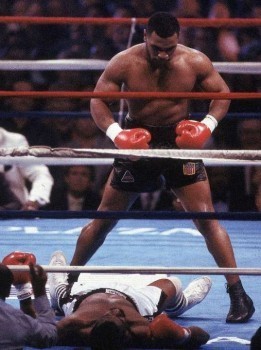
Mike would knock them out early in the first round. When he was 16 years old his opponents feared facing him. Some would even back out or plead no contest. At this point Mike had a powerful winner effect going for him.
Much later, when Mike Tyson came back from his 3 year jail sentence and planned to reclaim his title, Don King used the same strategy. He gave Tyson two easy fights before the title to build up his confidence. Tyson scored a first-round knockout vs Peter McNeeley, and then a third-round knockout vs Buster Mathis.
When he finally faced the current champion, Frank Bruno of the UK, Mike won that fight (unimpressively) on a TKO and reclaimed his belt. If he hadn’t scored those two easy wins he might not have even done that.
In other words: The winner effect is important for your motivation and self-esteem.
And, fortunately, the winner effect doesn’t just apply to beating people up. For example, chess players and (video) gamers are affected by it too.
Some of the main ways you can use the winner effect, and get the positive boosts in testosterone and dopamine, is by:
Consistently outdoing yourself
Breaking (personal) records
Winning competitions
Rising to the top of a social hierarchy
And the question then becomes: What is the smartest way for doing this?
That, my friend, is via incremental change (improvement).
By deliberately setting yourself up for a streak of “small” consistent victories.
But wait. . .
. . .There’s more.
There’s also another psychological reason why it’s better to pace your progress towards your goals, as opposed to making sudden spurts. And this reason is that. . .
You Want Positive Things to Happen Incrementally
And vice versa — you want the bad stuff to come all at once.
Why is this?
Well, it’s because of how the brain’s wired.
Here’s an excerpt from Peter Bevelin’s Seeking Wisdom:
“Mary never wraps the kids Christmas presents in one box.”
Since our experiences seem longer when broken into segments, we like to have pleasurable experiences broken into segments but painful ones combined. That is why Mary puts presents n many boxes. Frequent rewards feel better.
Frequent rewards feel better.
Read on, and this will make more sense.
We prefer a sequence of experiences that improve over time. Losing $100 first and then gaining $50 seems more rewarding than gaining $50 and then losing $100. We want to get rid of the bad experiences first. Immediate losses are preferred over delayed ones. Just as we don’t like bad experiences, we also don’t like waiting for them. We like to get over them fast.
So, the implications of this are that:
To boost motivation and good emotions: You want to set yourself up for a sequence of consistently improving events, even if just slightly.
To minimize drain on motivation (sadness, grief, etc): You want the negative stuff to be over with as fast as possible.
This is important to know.
O.K.
Now you know how to build self-esteem, set goals, and keep yourself motivated in executing consistently on your goals each day. But I know what you’re thinking: Are there more motivational tricks you can use?
Yes there are.
So let’s go over a number of psychological tricks that you can — and should — combine with what you’ve already learned. Starting with how to. . .
Understand And Use the Power of Consistency
Because your brain is biased for consistency in many ways.
First, I want to show you a few ways in which most people unknowingly use this against themselves. And you want to avoid that.
For example, if someone tells you something nice like: “You’re so confident and smooth”, guess what will happen?
You’ll want to live up to that. And you will want to act in congruence with the expectations placed upon you. Skilled negotiators know this, and give their opponents compliments early in the negotiations to get a better deal:
“Wow, you really did a good job giving us all the details. You’re such a nice guy Rob, you always give us a great deal.”
When Rob hears that he’ll unconsciously want to act nice and give the other guys a good deal (if he’s a poorly trained negotiator). This is sometimes called “The Pygmalion Effect“. (More on this soon.)
Another aspect of the consistency bias is the concept of cognitive dissonance. If you take some specific action you will post-rationalize your thoughts to create a compelling narrative which explains why you did it.
For example, let’s say you’re driving on the highway, and you see a guy on the sidewalk who looks like he’s cold and hurt. But for some reason you’re slow to react to this, and you unwillingly drive past him. What will happen?
Here’s what you will probably think:
“I should’ve stopped to help him. . . But. . . Whatever. Some other person driving past will help him anyway. Besides, I need to get to my meeting now. Yes. I’m really busy. I don’t have time to turn back.“
Here’s another example, assuming you’ve skipped going to the gym for some bullshit reason:
“I didn’t go to the gym because I. . . I. . . felt tired. That’s right. And they say it’s a bad idea to lift weights when you’re tired. Yeah. . . I could get seriously hurt. And I don’t want to risk my life. Yeah, I’m too smart for that. Good thing I didn’t go to the gym!”
Consistency bias is a powerful thing, and it has a wide range of application.
It applies to ideology, beliefs, and your actions.
Say you decide to go the cinema with someone on a first date. Then the two of you sit down to watch the movie, and 30 minutes into it, you both realize that the movie SUCKS.
Your date is headed for disaster!
You better do something.
The rational thing then is to do something else. Something different: To leave the cinema and choose a course of action that yields a higher value for the time the two of you spend together. Right?
Right.
But that’s NOT what will happen.
Nope.
Here’s what’s going to happen. . .
. . .You’ll both shut up about it and pretend watching the movie is fun.
Why is this?
It’s because:
You’ve invested money in buying tickets
You’ve invested 30 minutes of time watching the movie, plus the time it took you to walk to the cinema
You’ve invested your social status — you don’t want to “make a scene” by walking out of the cinema while everyone’s watching the movie
And, maybe the most important psychological aspect in the case of a first date: You’ve invested yourself emotionally. . .
. . . And so, you care — a lot — about how you’re going to be perceived by the other person. You want that person to like you.
Meaning: You don’t want to admit you made a bad decision. Because it could backfire and make you or the other person — who is equally invested — look bad and get uncomfortable. And the other person may dislike you for pointing it out!
So in all likelihood, you’ll shut up about it and endure the boredom. And what happens next?
You guessed it — cognitive dissonance!
You start convincing yourself that the movie really is good after all. And that you really did make a good decision. And you will probably be successful in deluding yourself about this. . .
. . .Just like the losers (who don’t have real self-esteem) I told you about in the beginning delude themselves with “feel-good” beliefs.
Then, as you and your date walk out of the cinema hand in hand, you both agree it was a great movie and you had a good time.
Then you never talk about it again.
Because it wasn’t a good movie and you don’t want to admit you made a mistake in watching it.
Alright.
Now you know — and can anticipate — some of the ways in which your brain tricks you out of doing the “right thing”.
Let’s turn it around and look at how you can use this stuff to your advantage, starting with how you can. . .
Tap Into the Power of Consistency
Because it’s powerful.
And as you realize, most people are using various consistency principles against themselves.
Now, the first thing you want to know when it comes to using your brain’s bias for consistency is. . .
The Pygmalion Effect
Which is a catchy name for explaining the fact that our expectations or thoughts of ourselves are self-fulfilling. If you think good things about yourself you will form higher expectations of yourself. Higher expectations make you bolder.

In Greek mythology, Pygmalion was a sculptor who fell in love with one of his statues and started kissing it in hopes that it would turn into a real woman. Then it did — and it got pregnant.
This is one of the reasons why affirmations (autosuggestion) and complimenting other people improves self-esteem and performance.
If you think that you are a winner — you soon will be.
This means that starting now you will. . .
. . .Never think, speak, or write negatively about yourself.
Because it may become a self-fulfilling prophecy that puts you in a “loser effect”.
On to the next one. . .
The Consistency Chain
Which is my own catchy name for building up a streak of consistent actions.
The power of the consistency chain lies in the fact that once you do something every day consistently — without fail — for a long time in row you will want continue what you’re already doing. It’s based on a combination of psychological principles like loss aversion, the sunk cost fallacy, and formation of habits.
This changes your thinking from, “I shouldn’t smoke a cigarette today” to, “I haven’t smoked for 40 days, and I’m not about to start today!”
Once you’re started you don’t want to “break the chain”.

“Now who’s the greatest?”
Most people don’t have the guts to do that. They’re afraid people might think they’re arrogant, and that they’re bragging.
But . . .
it’s not bragging if you mean it.
There’s a big difference between being cocky and being confident. If other people aren’t smart enough to understand this — screw ‘em.
Tell yourself you are the best and act as if it were true.
In some countries — like Sweden — people losers will tell you to be more humble. How do you deal with this?
You don’t. You ignore them. No one cares for a humble loser anyway.
You can be humble when you’re a winner.
Got it?
Good.
How to Be a Winner Every Day
Now that you know about the positive feedback loop of momentum you want to start using it in your own life.
Here’s how:
You build real positive self-esteem by executing on your goals. And you set goals by answering the questions:
What do I want?
How can I get it?
What do I need to do specifically?
Then you turn that goal into something measurable that you can take action on every day. Time-oriented or result-oriented daily goals. And then? You execute like a madman.
Your self-esteem isn’t just based in achievements –it is mostly based in your consistency of execution. You build self-esteem incrementally, bit by bit every day by breaking records, doing scary things, and creating new references points.
You want to set yourself up to use the “winner effect” as soon as possible. You deliberately set yourself up for a series of consistent victories and build confidence a little at a time. You enter the self-reinforcing cycle of dopamine and testosterone.
Incremental change builds more motivation than sudden change does. You want the good stuff — the rewards — to come incrementally. And you want the bad stuff to come all at once.
Your brain is wired for consistent behavior. There are many explanations for how consistency tricks your thinking. This can be both a bad and a good thing. For most people this is a very bad thing. Because they unknowingly let it work against them. You must find ways to use this to your advantage by using. . .
–The “Pygmalion Effect” by only ever thinking, speaking, and writing positively about yourself.
–The “Consistency Chain” by turning your goals into a format which allows you to take action towards it every day and lets you build a long chain of consistent execution. Then you add a visual element to remind yourself of your progress and achievements (see resources below).
–The “Commitment Tendency” by putting your goals (no matter how small) in writing or by stating them in public and making yourself accountable.
When you combine these psychological principles you will become a machine – a momentum machine.
Resources:
Start building a “consistency chain” right now by printing this free and ready-made 30-day calendar. Then you put up on your wall and draw an X for every day you take action on your goal.
Learn more about neuroscience (and the winner effect) over at professor Ian Robertson’s site. Here are some free lessons
Photo credit:
The post How to Become a Momentum Machine: Combine Powerful Psychological Principles to Boost Motivation, Build Self-Esteem, And Be a Winner Every Day appeared first on Startgainingmomentum.
August 4, 2014
How To Understand And Use The Power of Incremental Change (and why most people don’t)
 I’ve often had the bad luck of being trapped in the same room with irritating flies.
I’ve often had the bad luck of being trapped in the same room with irritating flies.
This really annoyed me. . .
. . .Until I learned a really smart method for killing those bastards.
And it works flawlessly every time.
What’s that? You want to know my method?
Ok sure. I’ll tell you. It’s no big secret.
To become a good at killing flies you must think like a ninja: You can’t let them see you coming. This might seem difficult, seeing as how flies have a 360 degree field of vision (pun not intended).
But it’s not difficult at all — it’s actually very simple.
Here’s what you do:
You pick up a newspaper — or something else to smash the fly with — and you move it very slowly, incrementally, towards the fly. Then, when you get a couple of centimeters away from the fly, you thrust the object towards the fly and crush it.
They never see it coming, not even the fastest and nastiest of flies. I promise, they don’t stand a chance against you when you use this method. Do you know why?
It’s because flies don’t understand. . .
The Concept of Incremental Change.
Their brains aren’t complex enough to perceive it. They only react to sudden changes — movements with an accelerating speed that goes past a certain sensory threshold.
Insects have only around 100, 000 cells in their entire nervous system. Humans, however, have billions of cells in their brains alone.
So, if I wanted to kill you (not that I would, I’m a nice guy) and I picked up a knife and tried to use my fly-killing method, you would probably just laugh at me.
However. . .
While insects — with their limited brain capacity — cannot sense the incremental change over the course of a few seconds. . .
. . .Most humans cannot sense incremental change taking place over the course of minutes, hours, days, and years.
Why is this?
Is It Because Our Brains Suck?
Well, not really.
Our brains don’t necessarily “suck”. They work just fine considering what they’ve been used for up until recently.
Our brains do what they’ve been fine-tuned to do through evolution, via the Darwinian process of natural selection.
The problem is that the world has changed a lot over the past few thousand years — but our brains have NOT.
Culture and technology evolves MUCH faster than our genes (and brains) do.
It’s one thing to say this, but it’s another thing to really understand the implications of what I’m talking about here. So, let’s put things in perspective, shall we?
Let’s Review the History of the Human Race in Less Than a Minute
Humans have been around for about 4-7 million years.
The human race has spent the vast majority of its time living as hunter-gatherers. It’s in this environment our brains evolved.
Homo sapiens — which is what you and I are — first came around 200,000 years ago. We are the last surviving human race. Hobbits were the last human species to go extinct.
10,000-12,000 years ago we invented agriculture. This led to a decline in hunter-gatherer and tribal living. People started settling down at fixed locations instead of living like nomads.
From that point on until around 2000 years ago we became a lot better at growing food, and survival became easier. We created communities which eventually grew into villages, towns, and sometimes even cities.
Then in the last 400 years we’ve seen rapid technological progression, especially during the industrial revolution. Cities have grown in size tremendously. Tokyo now has 13 million inhabitants and New York has 8.5 million.
We now live in the information society since around 1980. And the rate of technological progression is speeding up — the world is changing faster than ever before.
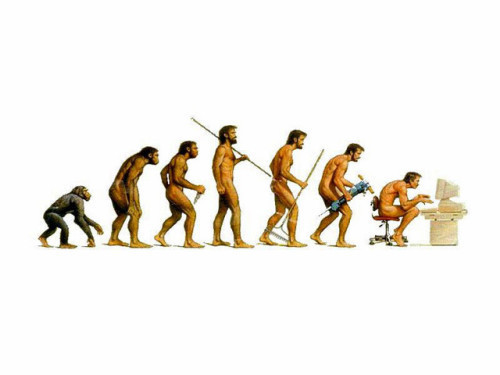
We are now knowledge workers living in the information society
Let’s talk more about the information society.
Here’s the Wikipedia definition of an information society:
An information society is a society where the creation, distribution, use, integration and manipulation of information is a significant economic, political, and cultural activity. The aim of the information society is to gain competitive advantages internationally, through using information technology (IT) in a creative and productive way. The knowledge economy is its economic counterpart, whereby wealth is created through the economic exploitation of understanding
So, the big thing here is that to thrive in the information society, you need to be good at handling a lot of information. You need to be good at learning things. You need to understand what the information means — and how you can use it.
As the economist Tyler Cowen says in his book Average Is Over: Powering America Beyond the Age of the Great Stagnation Average is Over:
Average is Over:
The more information that’s out there, the greater the returns to just being willing to sit down and apply yourself. Information isn’t what’s scarce; it’s the willingness to do something with it.
And “to do something” with it requires what? Willpower. Motivation. A goal.
But, wait.
There are some other aspects of the information society I “forgot” to mention.
. . . For example, there are new types of behavior such as:
Spending lots of time indoors — in cubicals and such
Sitting in front of computer screens
Using smart phones — with unlimited access to the Internet
Getting text messages and email
Having unlimited access to social media sites
Having unlimited access to porn
And other ways to get instant gratification.
Of course, you know this just as well as I do.
The question then becomes. . .
Do You Think Our Brains Have Adapted to This?
I’ll tell you: In the 34 years we’ve been in the information society, there’s no way in hell our brains have adapted to these things!
But the scary thing is that most people don’t reflect about any of these things. Not even about the social networks which they so happily spend waste several hours per day on.
Social networks have turned the world on its head. Because of this, life for most people has changed dramatically in just the last 10 years; the way business and marketing is being done has changed. The way we connect with people has changed. And much more. . .
But still, most people don’t even think about it. Why is this?
Yeah, I think you can guess the answer by now. It’s because these things — these technological progressions — happened incrementally over an extended period of time.
And by default, our brains are NOT made for understanding these things; just the same way the fly that doesn’t understand that the newspaper is moving towards it until it’s too late — and has its intestines smeared all over my wall. The question is. . .
Are You Smarter Than a Fly?
Yes?
I should hope so.
However, even if we humans are smart enough not to fall for the fly-killing method we will often be tricked by slightly more advanced methods that operate by the very same fundamental process — the process of incremental change.
For example. . .
. . .The magician David Copperfield invented a famous trick for disappearing the Statue of Liberty. He had placed a group of seated onlookers upon a platform. And right in front of them was the Statue of Liberty, situated between two pillars. Copperfield then placed a large screen between the two pillars to block their view of the Statue of Liberty for a minute or two.
When he removed the screen, the onlookers could no longer see the Statue of Liberty.
It had “disappeared”.
How did he do it?

David Copperfield “disappeared” the Statue of Liberty by incrementally rotating the platform, until it was blocked out of sight by a pillar
Copperfield had placed the onlookers on a stationary platform, which was then rotated at a speed below the sensory threshold.
The onlookers did not feel that the platform was being rotated 45 degrees to the side– because it happened incrementally. When Copperfield removed the screen the Statue of Liberty was “gone”. It was now blocked behind one of those pillars.
Pretty cool trick, huh?
Speaking of magic. . .
Another guy I think is really entertaining and charismatic, and someone who also knows how to use the process of incremental change. . .
Is The Illusionist David Blane
David Blaine recently perfected a trick where he sticks a needle through his hand, or through his arm (as seen in the clip below).
How the heck does he do that?
What is the trick?
The trick is that. . .
. . .There is no trick!
He’s really doing it.
But how can he stick a sharp object through his hand or his arm without bleeding, and without crying out in pain?
Well, the reason it doesn’t bleed is because David went to an MRI scan 12 years ago to find the perfect spot. He then practiced sticking acupuncture needles through those spots for a few years. [Take a second to imagine how badly he must've wanted to pull off this trick to go through this.]
Eventually, when the acupuncture needles got too easy or him, he started using sharper objects, and began pushing deeper. Until he got all the way through his hand/arm.
Eventually he produced scar tissue all throughout his arm and his hand on these specific spots — sort of like a permeable membrane — which he could then use to put sharps objects through.
David is really proud of this trick.
And the reason for that is because everyone thinks it’s “magic” — when it’s not.
People can’t explain what’s going on. So they’re left wondering. . .
. . .How did he do that?
And most people simply can’t figure it out, even though the answer is right in front of them.
It just doesn’t enter their mind that someone might sit around for years and practice piercing himself with sharp objects. It’s too bizarre.
But, more importantly, the reason they can’t figure it out is because they’re not familiar with thinking about the process of incremental change. And this is normal. The brain – by default — does not understand incremental change.
But it can learn to understand it — and start thinking in terms of it — through practice. By practicing what, you ask?
Two things:
1)
You must regularly engage in the mental practices of long-term thinking and imagination.
For example by mentally projecting yourself into the future and:
Imagine being 70 years old giving yourself advice.
Imagine what your life will be like 1, 5, 10, 30 years from now — given that you do take some big action.
Imagine being much older, looking back at your life, and thinking about what you regret the most in your life.
2)
You must practice putting things in perspective.
Studying history is a fine way of doing this. The reason you want to put things in perspective is because it gives you a reference point which you can use to compare things with.
Our brains are made for comparing things, and without putting things in contrast to each other, we will miss changes. This is why tracking your results by writing or taking pictures is a good idea.
Let’s take the example I gave earlier about human history and put it in perspective by quantifying it. We assume the human species has been around for 4 million years:
This means that humans have spent more than 99% of their evolutionary history in the hunter-gatherer environment. If we compress 4 million years into 24 hours, and if the history of humans began at midnight, agriculture made its appearance on the scene 23 hours and 55 minutes later.
–Peter Bevelin, Seeking Wisdom: From Darwin to Munger, 3rd Edition
Seeking Wisdom
Let’s take that one step further by considering how long we’ve lived in an information society. How long would those 34 years be, in terms of the 24-hour analogy?
It would be 5,1 seconds!
Do You Think That’s Enough Time For Our Brains to Have Become Adapted to The Information Society?
Yeah. . .
Maybe. . .
Not!
5,1 seconds is NOTHING. In no way have our brains become adapted to the information society.
In other words, there’s a big problem going on here — and that problem is that. . .
. . .Our brains are NOT fit for modern society.
Not by default anyway.
If you want to grow beyond that — by practicing higher levels of thinking — then that’s up to you.
No one is going to help you think long-term. No one is going to put things in perspective for you.
As you know, most of society is geared towards instant gratification. . .
. . .And growing beyond that — and starting to think differently from other people – can feel pretty lonely at times.
As I’m sure you know as well.
Alright.
Onward.
Let’s take a look at a couple of big areas where incremental change is put to use. Starting with. . .
Politics, Power, And Freedom
Have you ever heard someone say that if you put frogs in a pot of water and turn on the heat, they will eventually let themselves be boiled to death?
This is supposedly so because the frogs can’t sense the incremental increase in temperature.
Well, don’t believe everything you hear. It’s not true.
But, it’s still a very memorable anecdote for conveying one aspect of incremental change.
And if you look through history, in any given culture where some group of people came to power, it has usually happened in an incremental way.
Nazi Germany is a good example of this. When people look back at WW2, one of the most common questions is: How could people allow the Jews to be treated like that!?
And well, you know the answer by now. . .
. . .Because it happened incrementally.
The Nazis didn’t just wake up one day and say: Let’s exterminate the Jews. It took them many years of negatively influencing the public perception about Jews before they were able to get away with treating them like they later did.
The order of events went something like this. . .
The Nazis started with blaming the Jews for everything that was wrong, then they made it harder for Jews to get into university, then they created a national Jewish boycott, then they started confiscating their belongings, and finally they started turning them into slaves and putting them in concentration camp.

The Nazis (Hitler & Goebbels) came up with the idea to boycott Jewish goods, after they had
None of that happened suddendly.
The lesson is this:
You don’t take away someone’s rights or their freedom over the course of a night.
But you can do it over a longer period of time. Incrementally. By tiny imperceptible steps.
All smart politicians know this — they know that most people don’t understand the process of incremental change.
Smart politicians know that most people have the memory of an ant, with little ability for doing any type of long-term thinking, and that they do not study history.
Brands And Advertising
You probably can’t tell me all of the world’s top #100 brands — at least not off the top of your head.
But you probably can recognize most of them if you look at their logos.
Why is this?
It’s because the big companies have spent incredible sums of money on advertising over the course of many years. You’ve been unconsciously exposed to them in movies ever since you were a kid.
Companies do this because they want to give you a feeling of familiarity. And if they do a really great job at it, their brand may end up becoming part of your Dunbar’s number and identity. As you know, there are lots of people who see themselves as “Apple people”.
But, what if a big brand decides it wants to change its logo?
Well, if they’re smart, they’re going to do it incrementally. Very slowly, by making tiny changes each year. If they do a great job, you won’t even notice the change.
And if they don’t do a good job?
Then they do a bad job. (Sorry, couldn’t stop myself)
No, but seriously. . .
. . .If they do a bad job — then they completely and suddenly change their logo beyond recognition.
Which means that many of the positive long-term effects they gained from years of investing in advertising have gone down the drain.

Coca Cola has changed its logo incrementally, over a period of many years.
Let’s look at Coca Cola. They’ve understood this aspect of incremental change as good as anyone. They’ve made very incremental changes in their logo over the course of a long time.
That was smart of them.
But, Coca Cola was not smart enough to understand another aspect of incremental change when they. . .
Changed Their Flavor to New Coke!
Big food and beverage companies like Coca Cola spend enormous sums of money in coming up with better-tasting formulas and flavors. So that they can put in chemicals and potent additives that taste much better than natural ingredients would. Why do they do this?
Well, first because it’s cheaper than buying real ingredients. But more importantly, they want their products to be as addictive and stimulating as possible, which is why they’re always loaded with stuff like caffeine and sugar.
Once you get used to drinking a soft drink like Coke, it’s becomes hard to stop because, other than the fact that it’s physically addictive, your brain also forms all sorts of positive associations with the drink. You link these positive associations to the Coca Cola brand, and to the flavor of the drink.
So, when these companies come up with a new flavor that tests really well, and outperforms everything else it’s tested against, should they replace the old flavor?
Yes?
That’s how Coca Cola reasoned in 1985 when they decided to use the new flavor — New Coke.
But this turned out to be a HUGE mistake. . .
. . .Which caused a minor national disaster. Just think about it: imagine that you have millions of people addicted to your product, which they consume several times per day, and then — suddenly — without warning, you take it away from them!
Bad idea.
People don’t like it when you change things too quickly.
And they also don’t like it when you take away things from them which they have grown familiar with — or even grown addicted to.
So that was a bad move by Coca Cola. . .
. . .And in doing that, they also made another big error: They lost all the positive psychological associations they had created and linked to the old flavor.
They lost their hard-earned sense of familiarity, which they had spent billions of dollars creating.
They panicked and quickly went back to using the old familiar flavor again.
If they had instead made the change incrementally, people wouldn’t have noticed a thing.
Key Takeaways on Understanding And Using Incremental Change
In this article I wanted to give you an understanding of how powerful the concept of incremental change is — how wide its application is — and why most people don’t understand it.
Summary:
For 99 % of the time that humans have existed we’ve lived in a hunter-gatherer society. This is the environment where our brains have evolved.
We now live in the information society, and our brains are not made for this environment.
For multiple psychological reasons, the human brain has trouble understanding the concept of incremental change.
Our brains do NOT grasp the concept of incremental change by default. It’s a higher level of thinking, and it requires practice.
The way to become a better thinker — and understanding incremental change — is by regularly engaging in the mental practices of:
Putting things in perspective (for example by studying history or quantifying things)
Using your imagination as much as you can
Practicing your long-term thinking and projecting yourself into the future (for example by thinking about your legacy)
And don’t think these things don’t apply to you — because they do.
Next time, I’m going to show you one of the most powerful ways that you can use incremental change to boost your personal development and become more motivated.
Talk to you soon.
Questions:
Do you know any useful ways for thinking long-term or for putting things in perspective?
Do you have any good practical examples of incremental change?
Resource:
Interactive timeline of human species by the Smithsonian.
Photo credit:
The post How To Understand And Use The Power of Incremental Change (and why most people don’t) appeared first on Startgainingmomentum.




